| William
Caxton William Caxton was born in Kent between 1415 and 1424. He was
apprenticed to Robert Large, a mercer, probably when he was about
fourteen or a little older. At some date between 1444 and 1449 he
went to Bruges, then a thriving merchant town. Because of its
predominance as a market, merchants from all over Europe gathered
there and established themselves in national communities ruled by
a governor. The English community was known as Merchant
Adventurers and Caxton became their governor in 1462. He probably
sold cloth and other goods including manuscripts, for Bruges was
the centre of a flourishing trade in manuscripts and paintings.
In 1469 or earlier Caxton decided to learn how to print and by
using this knowledge to produce books in English for sale in
England to the nobility. Having acquired a copy of the French
version of the History of Troy, he started to translate it
with the intention of printing the finished translation. The
outbreak of civil war in England led him to postpone his plan.
When after two years Edward IV was safely re-established in
England he resumed his project, with the patronage of Margaret of
Burgundy, Edward’s sister. He quickly finished his
translation and went to Cologne to learn the art of printing.
The first book Caxton printed, and the first book to appear in
English, was his own translation of the History of Troy.
It probably appeared in late 1473 or early 1474. In all he
printed six or seven volumes before returning to England; these
bear no place or date of printing but were almost certainly
printed at Bruges.
At Michaelmas, 29 September, 1476, Caxton’s name was entered
on the account roll of John Estency, Sacrist of Westminster
Abbey, as paying a year’s rent in advance for the premises -
probably a shop - in which he set up his press. The first known
piece of printing done in England, a Letter of Indulgence by John
Sant, Abbot of Abingdon, with the date of purchase 13 December
1476, issued from this press. Its existence was unknown until
February 1928, when it was discovered at the Public Record
Office. The first dated book printed in England, The dictes or
sayengis of the philosophres, was completed on 18 November
1477. This book was translated from the French by Caxton’s
friend and patron, Earl Rivers. It was followed by nearly one
hundred other works before Caxton died in 1491. Of these he was
personally responsible for the translation of about twenty-five,
besides editing nearly all of them. He made little attempt to
educate or lead public taste, but printed what it was easy for
him to know was popular, or what the prevailing predilection for
religious writings made a certain success. Romances and poetry
were another reasonable venture, while a few works of instruction
completed his list. He also worked under patronage in many
instances, so that of seventy-seven original works published by
him we know that for twenty-three of them he was assured of
financial support, and the favour of influential personages.
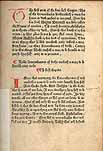 |
CORDIALE
Cordyale, or Four last thinges.
Westminster: William Caxton, 24 March 1479 Bv. 2.
21
The French original of this work, entitled Les quatres choses
derrenieres, was translated from the Latin, attributed to
Gerard van der Vlyderhoven, by Jean Mielot, secretary to Duke
Philip the Good of Burgundy, and was printed by Caxton at Bruges
about 1475-6. This English version is by Anthony Woodville, Earl
Rivers, who was the brother-in-law of King Edward IV, and had
accompanied him on his flight to the Low Countries in 1470.
Caxton and Rivers probably met for the first time towards the end
of Caxton’s stay in Bruges and Rivers translated The
dictes or sayengis of the philosophores, which Caxton issued
in Westminster on 18 November 1477.
This was the Harleian copy. In 1743-5 it was in the possession of
Thomas Osborne, a London bookseller, to whom the Harleian Library
had been sold by Edward Harley’s widow. In 1773 this copy
appeared again in James West’s sale (catalogue p.114,
no.1873) and was sold to William Hunter for £14. |
CHRONICLES OF ENGLAND
The Chronicles of England.
Westminster: William Caxton, 10 June 1480 Bv. 2.
31
This work, compiled by Caxton, is largely based on the Brut
which gives an account of the history of England from the time
that "Albyne with his susters entred into this isle"
until the accession of Edward IV. From 1480 to 1528 the Chronicles
of England was always in demand and copies of not less than
twelve editions survive.
With this is bound Discripcion of Britayne, issued by
Caxton on 18 August 1480 as a supplement to the Chronicles of
England. It is an extract from the translation made by John
Trevisa in 1387 of Ranulph Rigden’s Polychronicon.
GODEFROY of Boloyne
Godefroy of Boloyne, or the siege and conqueste of
Jherusaslem, or Eracles
Westminster: William Caxton, 20 November 1481 Bv. 2.
29
This work was translated from French by Caxton himself. The text
which he used is to be found in a fifteenth-century illuminated
manuscript on vellum in the British Library. An edition was
printed at Paris in 1500 with the title Les faits et gestes de
preux Godefroy de Bovillon et de ses chevelereux freres Baudouin
et Eustache.
This copy belonged in 1650 to Mathew Goodwin. In 1776 it appeared
in the sale of John Ratcliffe’s library, when it was bought
by George Nicol, a London bookseller, who presumably sold it to
William Hunter.
HIGDEN, Ranulph
Polycronycon
[Westminster: William Caxton, after 2 July 1482] Bv. 2.
9
Higden’s Polychronicon had been written in Latin in
the first half of the fourteenth century and translated into
English in 1387 by John Trevisa, chaplain to Lord Thomas of
Berkeley, at the request of his employer. Caxton added his own
prologue, inserted a table of contents and continued the
chronicle to 1461; Trevisa’s translation had ended at 1357.
William Hunter bought this copy at John Ratcliffe’s sale in
1776 (catalogue p.86, no.1669).
CATO Dionysius
The book callid Cathon.
[Westminster: William Caxton, after 23 December 1483] Bv. 2.
16
Caxton dedicated this book to the City of London and in his
prologue he compares the customs of Rome with those of London.
The distichs of Cato had been translated by Benet Burgh, then
vicar of Malden in Essex and later High Canon of St.
Stephen’s, Westminster, where he may have known Caxton, who
translated the extensive gloss from a French original.
An early owner of this copy was Francis Laxton. Later it was in
the Harleian Library and then in that of James West (1704-1773)
who was Treasurer of the Inner Temple and President of the Royal
Society. At West’s sale in 1773 it was bought by John
Ratcliffe for £4. 7. 6. and William Hunter bought it at
Ratcliffe’s sale in 1776 (catalogue p.73, no.1427).
LYDGATE, John
The lyf of our Lady.
[Westminster]: William Caxton, [1484] Bv. 2.
20
This book "was compiled by Dan John Lydgate, Monk of Bury,
at the excitation and stirring of the noble and victorious
prince, King Harry the Fifth". Lydgate, a monk of the
Benedictine Abbey of Bury St. Edmund’s, supposed to have
been born about 1375, was ordained a sub-deacon in 1389, a deacon
in 1393, a priest in 1397, arrived at his greatest eminence as a
poet about 1430, and died about 1461. After pursuing his studies
at Oxford, he travelled in France and Italy; returning home he
opened a school in his monastery and amused himself by writing
poetry. Riston called him a "voluminous, prosaick, and
drivelling monk", but Gray and Coleridge esteemed him
highly.
This copy belonged to John Ratcliffe and appeared as no.1218 in
the catalogue of the sale of his books in 1776.
VORAIGNE, Jacobus de
The legends named in latyn legenda aurea.
Westminster: wylyam caxton, [1487?] Bg. 1.
1
This is a mixed copy, containing sheets of both the first edition
printed after 20 November 1483, and the second edition, printed
about 1487. The last three leaves are for a shorter copy which
belonged in 1697 to John Finch. The volume was no.1865 in James
West’s sale, 1773, when it was bought by William Hunter for
£12. 5s.
The work is a collection of saints’ lives, each to be read
on a certain day in the Church’s calendar. The original work
was written in Latin between 1250 and 1280 by Jacobus de
Voraigne, Archbishop of Genoa. In the fourteenth century at least
two independent translations into French were made, a relatively
free one by Jean Belet and a more literal one by Jehan de Vignai.
About 1483 an English translation, known as the Gilte Lengende,
was made. Caxton’s translation is based on three
translations of the book, in Latin, French, and English. He
combined and adapted these, with many additions from other
sources. The finished work was one of the largest books Caxton
ever printed, a folio volume of just under 900 pages. At one
point he nearly abandoned the task in despair but he was
encouraged to go on by the Earl of Arundel who promised to take a
reasonable quantity of copies when completed and to pay him an
annuity of a buck in summer and a doe in winter.
The book contains seventeen folio-width woodcuts, including the
arms of Arundel and the life of Jesus, and about fifty
column-width pictures of Old Testament scenes and saints carrying
their emblems; it also contains the largest block that Caxton
ever used, a cut of the Saints in Glory.
BONAVENTURA, Saint
The myrroure of the blessyd lyf of Jhesu Cryste.
[Westminster:] William Caxton, [ca.1490] Bv. 2.
24
This is a copy of the second edition; the first was printed by
Caxton about 1486.
St. Bonaventura was born in Tuscany in 1221. In 1243 he became a
Franciscan, in 1253 a teacher at Paris, in 1256 General of his
Order, and in 1273 Bishop of Albano and cardinal. He died in 1274
during the Council of Lyons. He was the author of a number of
religious books, among which was his Speculum vitae Christi,
which was written for the guidance of a devout lady; it became
very popular and was several times translated into French. In the
early part of the fifteenth century Jean de Gallopes, chaplain to
John, Duke of Bedford and Regent of France, made a French prose
translation which bears a close resemblance to the text as
printed by Caxton; the author of this English text was Nicholas
Love. The book is illustrated with twenty-seven woodcuts of a very
much superior execution to those which had been previously in
use, they are not large but are simply and gracefully designed in
the Flemish manner.
This copy was no.1870 in James West’s sale in 1773, when it
was bought by Ratcliffe for £9. 9s. In Ratcliffe’s sale,
1776, it was no.1664.
See also the July 2000 Book of the
month
 |
The MYRROUR of the worlde.
[Westminster:] William Caxton, [1490] Bv. 2.
30
This work, at one time attributed to Vincentius Dellovacensis, is
an English version of L’image du monde (or Le
livre de clergie) which was probably written by Walter of
Metz, and was derived chiefly from the Imago mundi,
attributed variously to Honorius Inclusus, James of Vitry, Alan
of Lille, and others. This is a copy of the second edition; the
first was printed by Caxton in 1481. Caxton made his English
translation from a French text written in Bruges in 1464. The
first edition was requested and paid for by Hugh Dryce, a mercer
and alderman of the city of London, who intended to present the
book to Lord Hastings. It was the first book printed by Caxton
for which he had woodcuts made. Of them Edward Hodnett wrote:
"England stumbles on to the book-illustration stage with
some of the poorest cuts ever inserted between covers." They
represent schoolmasters and pupils, scholars with a globe, a
compass, figures, and other paraphernalia, a Salvator mundi,
the creation of Eve, and a woman singing from notes while a man
accompanies her on a flute.
On A2v of this copy there is an inscription stating that the book
was bought at Shrewsbury in 1510 from John Trustanes,
"scolar", by Thomas Botelar, "vicar of moch
wenlok". On A1r there are the signatures of Anne Greasbrooke
and William Barnsley. This copy was no.1017 in John
Ratcliffe’s sale, 1776, when it was bought by William Hunter
for £4. 17s. |
VIRGIL
The bok yf Eneydos.
[Westminster: William Caxton, after 22 June 1490 Bv. 2.
10
This version of the Aeneid was translated by Caxton from a
French paraphrase of parts of Virgil’s poem which reduced it
to a historical narrative in prose. The French version was
published at Lyons in 1483 by Guilleume le Roy, who was both
translator and printer. Gavin Douglas, in the prologue to his
Scottish poetical version of the Aeneid, writes thus of
the present work:
Thoch Wylliame Caxtoune had no compatioun
Of Virgill in that buk he preyt in prois,
Clepand it Virgill in Eneados,
Quhilk that he sayis of Frensche he did translait,
It has nathing ado therewith, God wate,
Nor na mare like than the Deuil and samct Austin.
Haue he na thank tharfore, bot lois his pyne;
So schamefully the storie did peruerte,
I reid his work with harmes at my hert,
That sic ane buk, but sentence or ingyne,
Suld be intitulit aftir the poete diuine.
The binding of this copy bears the armorial stamp of Sir Orlando
Bridgeman (1606?-1674) who was Chief Baron of the Exchequer, Lord
Chief Justice of Common Pleas, and Lord Keeper of the Great Seal.
Wynkyn de
Worde
Wynkyn de Worde was a native of the Duchy of Lorraine and is
thought to have been born in the town of Worth. He was brought to
England by Caxton, whose assistant he was and in whose service he
remained for some fifteen years until Caxton’s death in
1491. De Worde then took over Caxton’s house in Westminster
and his types and printed more than one hundred books there
before the end of the fifteenth century. Late in 1500 or early in
1501 he moved to Fleet Street in London, to a house opposite Shoe
Lane, at the sign of the Sun.
De Worde’s place in history is that of the first publisher
and printer to popularise the products of the printing press.
Duff calls him "by far the most important and prolific of
all the early English printers". He was responsible for more
than eight hundred publications, including romances, outline
histories, children’s books, instructions for pilgrims,
works on good manners, marriage, household practices, medicines
for horses, names of gods and goddesses, and husbandry. In
addition to his printing house, he had for a time a
bookseller’s shop in St. Paul’s churchyard with the
sign of Our Lady of Pity.
Either at the end of 1534 or the beginning of 1535, de Worde
died; his will, dated 15 June 1534, was proved on 15 January
1535. He was buried in the Church of St. Bride, near where he
worked. John Byddell and James Gaver, two of his assistants, were
made executors and continued to print in the same premises.
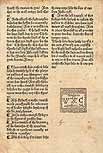 |
TREATISE of love.
This treatyse is of loue.
[Westminster: Wynkyn de Worde, 1493] Bv. 2.
19
Based on a French adaptation of Ancrene Riwle, this book
has sections on the Passion, the seven deadly sins, the signs of
spiritual love, the virtues of the apple tree, the love of Jesus,
and the avoiding of evil thoughts. With it is bound: The
chastysing of goddes chyldern, printed by Wynkyn de Worde
about 1494, which was the first book printed at Westminster with
a title page.
This volume was in the Harleian Library and from 1743 until 1751
or later it was in the possession of Thomas Osborne the
bookseller. It was no.1871 in James West’s sale, when it was
bought by William Hunter for £5 |
HYLTON, Walter
Scala perfectionis [English:] The ladder of perfection.
[Westminster:] Wynkyn de Worde, 1494 Bv. 2.
7
This first edition of one of the classics of English devotional
literature was the first book to which Wynkyn de Worde put his
name; a rhymed "enuoye" on the last leaf informs us
that "this heuenly boke more precyous than golde" was
printed "in Willyam Caxtons hows" at the special
command of Lady Margaret Beaufort, Countess of Richmond and
Derby, and mother of King Henry VII. It is the first and most
important of the books commissioned by Lady Margaret from Wynkyn
de Worde, who was later to style himself "Prynter unto the
moost excellent pryncesse my lady the kinges moder".
This copy was bought by William Hunter at James West’s sale
in 1773 for £2. 12. 6.
JEROME, Saint
Vitas [sic] Patrum. [English]
Westminster: Wynkyn de Worde, [before 21 August] 1496 Bv.
2. 13
The Lives of the Fathers were translated from the French by
William Caxton who "finished it at the last day of his
life". The words on the title page (and repeated on the last
leaf) are cut in wood, showing white on a black ground. The
woodcuts which illustrate the book are among the first which de
Worde commissioned. The series is copied with some reversals from
the edition of St. Jerome’s work on the desert saints issued
at Lyons in 1487 by Nicholas Philippe and Jean du Pre, one of the
editions on which Caxton based his translation.
This was the Harleian copy. William Hunter bought it at James
West’s sale in 1773 for £4. 10s.
ENGLAND. Laws, statutes, etc.
Statuta bonum publicum concernencia edita in parliamento
tento apud westmonasterium xiii, die Octobris anno regni ...
Regis Henrici septimi xi.
[Westminster:] Wynkyn de Worde, [1496] Bv. 2.
18
Four editions of these statutes were published in 1496, three by
de Worde and one by Pynson; copies of any of them are extremely
rare. This copy was sold as a duplicate from the British Museum
Library in 1769, presumably because they also had a copy on
vellum.
On the verso of the title page there is a large woodcut of King
Henry VII’s arms, which in this copy has unfortunately been
coloured by hand.
The MYRACLES of oure blessyd Lady.
Westmynster: Wynkyn de Worde, [1496] Bv. 3.
4
This is the only known copy of this work.
The woodcut of Calvary which appears as a frontispiece was used
first by Caxton about 1491 in his Book of prayers, and was
thereafter produced by de Worde in several works printed by him.
John Ratcliffe bought this book at the West sale in 1773 for 8s.,
and William Hunter paid 15s. 6d. for it when Ratcliffe’s
library was sold three years later.
GUIDO de Monte Rocherii
Manipulus curatorum.
In Ciuitate Londonensi: per Winandum de Worde, 1502 Cm. 2.
25
This work is divided into three parts: the first treats of the
sacraments, and the administration thereof; the second of
penitence, auricular confession, and the enjoining of penance;
the third, of faith, and what belongs to the information of the
people. It must have been popular for it had already been printed
by Pynson in 1490 and 1500, two editions, one by Pynson and one
by Notary, were to be issued in 1508, and de Worde was to reprint
it in 1509.
[CAPGRAVE, John]
Nova legenda Angliae.
London: Wynkyn de Worde, 1516 Bv. 2.
11
This work was known as Capgrave’s Lives of the saints. The
author was an Augustinian friar who was made Provincial of his
Order in 1456. He was a client of Humphrey, Duke of Gloucester,
whose life he wrote in Latin. In English he wrote lives of St.
Gilbert of Sempringham and of St. Katherine, also a chronicle of
English history extending to 1417. He died in 1464.
A woodcut of the Saints in Glory appears on both sides of the
first leaf and also on the recto of the last leaf. It depicts
twenty saints carrying their emblems, the Trinity enthroned, and
nine seraphim. This woodcut had already appeared in two editions
of Legenda aurea by Worde, 1483 and 1487, and he also used
it in editions of 1521 and 1527. There is also a woodcut of the
King’s arms facing the first page of the text.
William Hunter bought this copy at James West’s sale in 1773
for £2. 15s.
CATHERINE, Saint, of Siena
Dyalogues and reuelacyons of the newe seraphycall Spouse of
Cryste Seynt Katheryne of Sene.
London: Wynkyn de Worde 1519 Bv. 2.
26
"A ryghte worshypfull and devoute gentlyman, Rycharde Sutton
esquyer, stewarde of the holy monastery of Syon," finding
the manuscript of this work "in a corner by itselfe"
caused the book to be printed "at his greate coste". In
addition to red-letter chapter headings and other evidence of
special care, results of Sutton’s expenditure are visible in
eight large and fairly elaborate woodcuts representing the
visions of Saint Catherine.
This copy was bought by William Hunter at John Ratcliffe’s
sale in 1776.
The FLOURE of the commaundements of god.
London: Wynkyn de Worde, 1521 Bv. 2.
23
A translation by Andrew Chertesey of La fleur des
commandements de Dieu. There had been one previous edition
by de Worde, in 1510.
There are two woodcuts on the recto of the title page, one
showing Moses and the other a pope with a monk and a bishop
kneeling before him. On the verso of the title page there is a
woodcut of the Crucifixion which had previously appeared in Missale
secundum vsum Sarum, printed by J. Notary and J. Barbier for
de Worde in 1498. There are four other small woodcuts in the
text.
On the verso of the last leaf there are two inscriptions by an
early owner: "Robtus Dates Student off the myddill temple [
]" and "Iste liber ptnet ad me Robtum Date".
This was John Ratcliffe’s copy; it has his inscription
"Perfect" on the fly-leaf facing the title page.
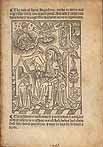 |
AUGUSTINE, Saint
The rule of seynt Augustyne, bothe in latyne and englysshe
/ with thwo exposicyons. And also ye same rule agayn onely in
Englysshe without latyne or exposicyon.
London: imprynted by Wynkyn de Worde, 1525 Bv. 3.
10
The translator was Richard Whitford, a member of the Brigittine
house at Isleworth, known as Syon House; he called himself
"the olde wretche of Syon". Whitford furnished de Worde
with a number of translations, of which this was the first.
There is an interesting advertisement on the title page:
"The traslatour doth aduyse & couseyll all ye disciples
of this rule to bere alway one of these bokes upo them syth they
ben so portatyue & may be had for so small a pryce".
In his preface "Unto the deuoute and ghostly reders"
Whitford says that he was required to make this translation seven
years ago and "I (the rather and more lyghtly) dyd graut
thereto / that I had not before yt tyme seen or herde of ony
other translacyon / but that was olde / scabrouse / rough / &
not of the englysshe comynly vsed in these partyes". He adds
that the rule was first written unto women and he has made this
translation for use by both sexes.
The two expositions are by Hugo of St. Victor and Whitford.
This was John Ratcliffe’s copy. |
William de Machlinia
John Lattou established the first printing-press in the City of London in
1480. In 1482 he went into partnership with William de Machlinia, a native of
Machlin (Malines) in Flanders. They printed five books, all law books and all
undated. Lattou then vanished and Machlinia carried on alone, producing thirty
known publications, of which eleven were legal works. He either retired or died
around 1490 and his business seems to have been taken over by Richard Pynson,
who used woodcut borders of Machlinia's and other materials.
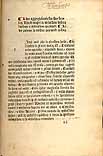 |
ALBERTUS MAGNUS
Liber aggregationis.
London: William de Machlinia, n.d.
Ah - a. 29
This copy belonged to William Herbert, 1718-1795, bibliographer and book
collector, and has his signature on the title page. It was purchased by
Triphook (a bookseller) at the sale of Dr. Combe's duplicates in 1808.
Later it was in the White Knights Library near Reading (George Spencer
Churchill, 5th Duke of Marlborough, 1766-1840) and at the sale of that
library in 1819 it was sold for £7. 10s. It was bought by Professor John
Ferguson of Glasgow University at the sale of the Syston Park Library (Sir
John Hayford Thorold) in 1884. |
ALBERTUS MAGNUS
De secretis mulierum.
London: William de Machlinia, n.d.
Ah - a. 30
This book was the subject of a paper, On a copy of Albertus Magnus' De
secretis mulierum, printed by Machlinia, which was read to the Society of
Antiquarians by Professor Ferguson in 1885. In this article he proves that the
book was printed by William de Machlinia and argues that this copy belonged to
William Herbert, and that it was originally bound with the Liber
aggregationis. Ferguson bought it at the sale of the Hamilton Library in
1884.
Richard Pynson
Pynson was a native of Normandy and probably learned his trade from Guillaume
Le Talleur of Rouen, whose device he later adopted. It is not known when he came
to England but he was there in 1482, when he was described as a glover. His
first dated book was the Doctrinale of Alexander Grammaticus (1492) but
this may have been preceded by various unprinted books.
Pynson continued to work in the parish of St. Clement Dane's, just outside
Temple Bar, from his arrival in England until the end of the fifteenth century,
during which time he printed over 100 items. In 1500 he was appointed King's
printer in succession to William Faques, the first to hold that position. This
appointment carried with it a salary of £2 a year (raised to £4 in 1515) and the
right to use the title of Esquire. In the following year he introduced roman
type into England, first using it to print a speech by the Papal Nuncio, Petrus
Gryphus. He also combined roman and black letter in a folio edition of The
ship of fools. According to A.F. Johnson, the roman type which he used came
from Paris.
Up to the end of the fifteenth century more than half of Pynson's output
consisted of religious works but in later years he devoted his attention mainly
to legal works and he published more of these than any other printer before
1557. He also published chronicles, encyclopaedias, poems, travels, and
scholastic manuals and he printed over seventy editions of the Year Books. It
seems probable too that he had for at least eighteen years the profitable
contract for printing the forms of admission to the Guild of St. Mary at Boston.
Pynson's work was superior to that of contemporary English printers, both in
letterpress and in illustrations. He died early in 1530 and as his only son had
predeceased him, his business seems to have been taken over by Robert Redman.
PROMPTORIUS puerorum, siue Medulla grammaticae.
London: Richard Pynson for Frederick Egmondt Petrus Post Pascha, 15 May 1499
in Cn.
1. 2
This is a copy of the first edition of a work whch was very popular in the early
sixteenth century and was reprinted by Notary in 1508 and by de Worde in 1511,
1512, 1516, and 1528. It is an English-Latin dictionary containing many old
English words which are nowhere else explained. Pynson's preface announced that
"humble grammarians and boys may look on this short volume as in a mirror, and
find freely and immediately the common words which belong to the Latin tongue."
Its sister work, the Ortus vocabulorum, was a Latin-English dictionary,
first printed by de Worde in 1500.
This copy bears the bookplate of Francis Blomefield, 1705-1752, topographer and
Rector of Fersfield, Norfolk, and the signature of Thomas Martin, 1697,
antiquary, of Palgrave, Suffolk, whose books were sold at various dates between
1769 and 1777.
ARS MORIENDI
Here begynneth a lityll treatyse ... of the art and crafte to know well to
die.
[London:] emprynted by Richard Pynson [before 1501]
Bv. 3. 14
This is the only known copy; it is a reprint of Caxtion's Ars moriendi,
which was published in 1491. The description of that edition in the Harleian
catalogue is as follows: "This important Subject, of such universal Behoof, as
wisely undertaken by Master Caxton, at the Age he was now arrived at, and under
the Decay he might feel upon him, which put an End to his laudable Labours,
before he was a Twelve-Month older. It is the more to be regarded, in that he
chose, by this Work, to set himself the Example of the Doctrine therein
inculcated. It is divided into six Parts; treating, of the Praise of Death, and
how we ought to die gladly; of the Temptations we are under at the Point of
Death; of the Questions that ought to be made at that Time; of the Instructions
that ought to be given; of the Remembrance of God's Doings and Sufferings for
us; of certain devout Prayers that ought to be said by, or for, the dying
Person. From all which Articles it may evidently appear, as the Author
concludes, that to every Person who would die well, it is necessary that he
learn to die, before Death comes, and prevents him."
This copy formerly belonged to John Ratcliffe and at the sale of his books in
1776 it was bought by William Hunter for fifteen shillings.
FISHER, John
This treatise concernynge the fruytfull saynges of Dauyde the kynge and
prophete in the seuen penytecyal psalmes ... was made ... by ... Johan fyssher
...
London: Richard Pynson, 1510
Bv. 3. 12
John Fisher was the Bishop of Rochester and President of Queens' College,
Cambridge. He was chiefly responsible for the foundation of Christ's (1505) and
St.John's (1511) colleges, acting for his patron, Margaret, Countess of
Richmond. It was at her "exortacion and sterynge" that this book was written,
and although it is not explicitly stated, it may be assumed that it was on her
instructions that de Worde first printed it in 1500. It was reprinted seven
times.
This is the Ratcliffe copy. It was bought by William Hunter at Ratcliffe's sale
in 1776 for 16s.
 |
CATHOLIC CHURCH. Liturgy and ritual
Missale ad vsum insignis et preclare Ecclesie Sarum.
Londini: per Richardum Pynson, 24 December 1520
Bg. 1. 2
This is the last of the four Salisbury Missals printed by Richard Pynson,
whose books have been asserted to be technically and typographically the
best of the English incunabula. Dibdin (Northern tour, ii, p.744)
notes that although this is a fine copy on vellum, the large woodcut of
the Crucifixion, which usually precedes the burial service, seems here to
have been inserted. |
[BONDE, William]
The pylgrimage of perfection.
London: Richard Pynson, 1526
Bv. 3. 15
The work is divided into three books, in honour of the Trinity. The first shows
how the life of every Christian is a pilgrimage; the second leaves the life of
the world and enters the journey of religion; the third contains the
self-pilgrimage in seven days' journey, according to the seven days in which the
world was made - the first five days relate to the active life of religion, the
two last to the contemplative life.
There are nine woodcuts and a diagram of tables. Most of the cuts had been used
several times before. On the title page is de Worde's useful St. Bridget which
had already been used by him six times and was to be used ten more times by
various printers. At f.91 there is a cut of the Tree of Vice growing out of the
mouth of the devil, surrounded by his fiends in hell.
With this is bound: The rosary of our Sauyour Iesu, printed by Pynson
about 1520. It contains two woodcuts whcih are also used in The pylgrimage of
perfection.
This is the Ratcliffe copy.
Julian Notary
Notary was a native of Vannes, capital of the department of Morbihan, on the
south coast of Brittany. About 1496 he began to print in London, in partnership
with John Barbour of Coventry and Jean Huvin, a Rouen stationer who dealt in
books for the English market. In 1498 the printing office was moved to
Westminster and by the following year Notary was working alone. At the end of
1500 Wynkyn de Worde left Westminster and very soon afterwards Notary followed
his example and moved to premises just outside Temple Bar, very likely the house
which Pynson had only very lately vacated. By 1510 he also had a shop in St.
Paul's Churchyard, and about 1515 he gave up his premises near Temple Bar and
moved to St. Paul's Churchyard.
Nothing is known of Notary as a printer after 1520. He printed in all
forty-eight books, mostly liturgical, and used three devices. Besides being a
printer, he was also a bookseller and bookbinder.
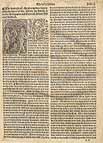 |
VORAIGNE, Jacobus de
Legenda aurea.
[London:] Julyan Notary, 1503 [1504]
Bh. 1. 1
This was the first dated book which Notary issued from his new premises in
London. The colophon reads: "Thys emprynted at temple barre be me: Julyan
Notary dwellynge in saynt clemetys parysshe." The book is illustrated with
woodcuts previously used by Caxton and Wynkyn de Worde, as well as five
crible metal engravings, all probably of French origin, and some curious
initials similar to those used by Andre Bocard.
This was John Ratcliffe's copy, with his inscription, "Perfect", inside
the front cover. It also bears the ownership inscriptions of John Batteley
(1647-1708), who was successively fellow of Trinity College, Cambridge,
domestic chaplain to Archbishops Sancroft and Tillotson, Chancellor of
Brecknock, archdeacon of Canterbury, and Master of King's Bridge Hospital;
and Ebenezer Mussell of Bethnal Green, collector of English incunabula,
fl. 1740-1782. |
GUIDO de Monte Rocherii
Manipulus curatorum.
[Londini:] impressum per Julianum Notarium, 1508
Cm. 2. 30
On the title page there is a woodcut of the Crucifixion which Notary had already
used in an edition of John Mirk's Liber festivalis, published about 1507.
Robert Redman used in again in 1532. On the verso of the last leaf there appears
the woodcut device which Notary began to use in 1507 in place of the simple
merchant's mark he had hitherto employed. The device was in two sizes; this is
the smaller of the two.
Only one other copy of this edition is known to exist; it is in the Bodleian
Library.
Peter Treveris
Peter Treveris probably came, as his name suggests, from Trier in Germany. He
worked in the borough of Southwark from about 1520 until around 1533. His first
dated book was issued in 1522 and his last book was printed for him in 1532 for
him by Rastell. During those ten years he printed at least thirty-six books,
mostly grammars, and he may have printed for de Worde many of the grammars which
bear the latter's imprint.
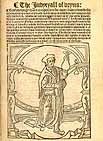 |
The JUDYCYALL of vryns.
[Southwark: Peter Treveris, 1527?]
Af - y.20
This is a compilation of "sentecyals sayngis of al auctours of phisike",
meant to provide the layman with a do-it-yourself manual of medical
treatment. It was the most popular medical book of the early sixteenth
century.
This copy has the bookplate of Alexander Young, a nineteenth century
Glasgow solicitor and book collector, and some notes by him on a fly-leaf.
He thought this was probably Herbert's copy but it does not have Herbert's
mark on the title page. |
RIGDEN, Ranulph
Polycronicon.
Southwark: imprinted by Peter Treueris, 1527
Bv. 2. 5
Treveris printed this work for John Reynes, a London stationer whose mark in red
is on the title page. The original design for the title page was in three parts
within an ornamental border surmounted by a crown. The first had the title and
Reynes' trademark in red; the second, medallions of the royal arms, the King,
and the arms of the City of London; the third a large woodcut of St. George and
the dragon. This was not considered satisfactory so the block was cut and the
layout seen here was adapted, with much more striking effect. The large woodcut
in its unaltered state, but without rubrication or the title, was used to adorn
the last part of the book. There are also seven woodcuts in the text.
Robert Redman
Redman issued his first printed book in 1523. In his edition of Magna Charta,
1525, he gave his address as at the sign of St. George in St. Clement's Parish;
this may have been the house formerly used by Pynson and Notary. Immediately on
Pynson's death early in 1530, Redman moved to Pynson's house, the George in
Fleet Street, and took over his business and three of his devices.
The greater part of Redman's work was confined to law-books and reprints and the
standard of his printing was poor. He died in 1540; his widow issued a few books
after his death, but ceased printing when she remarried, and the printing office
passed to William Middleton.
NEW TESTAMENT
The newe Testament in Englyshe and Latyn.
London: printed by Robert Redman, 1538
Ds- f. 12
This is a copy of the earliest diglot and contains Tyndale's English New
Testament with the Latin of Erasmus. Tyndale's translation of the New Testament
was the first to be printed in the English language. The first edition
definitely known to have been completed was printed, in all probability, by
Peter Schoeffer at Worms in 1526. A fragment of an earlier edition, probably
printed by Peter Quentell at Cologne, is in the Grenville Collection of the
British Library.
Tyndale, otherwise Hychyns, born about 1490, studied at Oxford, and afterwards
at Cambridge. By 1523 he had resolved that, if God should spare his life, before
many years he would cause plough-boys to know the Scriptures. Much discouraged
in London, he crossed to Hamburg, and completed his translations on the
Continent, using William Roye, a Cambridge student from a Franciscan priory at
Greenwich, as an amanuensis. At Antwerp in 1535 he was betrayed to his enemies,
and imprisoned in the Castle of Vilvorde, where he died a martyr in 1535.
"[Tyndale] established a standard of biblical translation which others followed.
It is even of less moment that by far the greater part of his translation
remains intact in our present Bibles, than that his spirit animates the whole
... His influence decided that our Bible should be popular and not literary,
speaking in a simple dialect, and that so by its simplicity it should be endowed
with permanence." - B.F. Westcott.
The TREASURE of poor men
Here beginneth a good boke of medecines called the Treasure of pore men.
London: imprynted by Robert Redman, 1539
Af-e. 62
This is one of the earliest English medical books. It contains numerous homely
prescriptions, mainly consisting of herbs, for instance: For stoppynge of the
Splenne. Take the Elder roote and sethe it in whyte wyne unto the thyrd pte &
drynke therof for it cureth merueylously.
Only three other copies of this edition are known to exist, one (which is
imperfect) in Britain and two in the United States. It has a printer's ornament
on the title page, woodcut initials, and Pynson's device on the verso of the
last leaf.
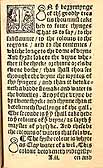 |
The SEEING of urines
Here begynneth the seynge of urynes.
London: imprynted by Robert Redman, [1540?]
Af.d.60
This work had first been published in 1525; it was reprinted eleven times
in the sixteenth century.
Urine inspection was a great stand-by of medieval medicine. It was
believed that any disease could be diagnosed by this method. At the end of
the book there is a short list of herbal remedies set out under the
different colours of urines, but the author apparently grew tired of this
and finished by referring "all they yt desyre to haue knowlege of
medycynes for ... urynes" to " the Herballe in Englyeshe or to the boke of
medycynes". |
Laurence Andrewe
Laurence Andrewe was a native of Calais, but about 1520 he was in Antwerp,
translating books out of Dutch into English for J. van Doesborgh the printer. He
then came over to England and borrowed £5 in money and £20 worth of printing
material from John Rastell. With the type thus obtained he printed The
vertuose boke of distyllacyon. The remainder of his work, so far as it has
survived, is undated. It includes a reprint of Caxton's Mirroure of the
worlde in folio, remarkable for its illustrations. Another of his
publications was The debate and stryfe betwene Somer and Winter, which he
printed for Robert Wyer who was apparently the publisher, as the colophon stated
that copies were to be had at his shop.
Andrewe would appear to have been in England in 1529, but meanwhile Rastell had
begun an action for the recovery of his money or his type, whereupon Andrewe
fled abroad.
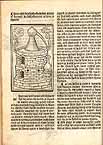 |
HIERONYMUS, von Braunschweig
The vertuose boke of the distyllacyon of the waters of all maner of herbes.
London: imprynted by Laurens Andrewe, 1527
Af-y.6
This is a translation by Laurence Andrewes of Liber de arte distillandi
de simplicibus, first published at Strassburg in 1500. It describes in
considerable detail the method of distilling herbs, in order to make use
of their virtues. It has a medical bias and displays a fairly high
standard of appreciation of the "theory" of distillation. The numerous
woodcut illustrations, most of them copied from the German Herbarius zu
Teutsch, include pictures of stills in all essentials - waterjacketed
condensers, fractionnated columns - similar to those used today.
This copy has the ownership inscriptions of Percy Smythe, sixth Viscount
Strangford and first Baron Penshurst (1780-1855), who was ambassador
successively at Stockholm, Constantinople and St. Petersburg, and
published Poems from the Portugese of Camoens in 1803. |
William Rastell
William Rastell was born about 1508 and after studying at Oxford he followed
the dual profession of printer-publisher and lawyer. While still studying law
(he was called to the Bar in 1539) he began to print about 1529 and, although he
was only active in this business until 1534, he issued more than thirty books.
In 1531 he had his printing office in Fleet Street, in St Bride's churchyard,
but no printer's mark of his is known.
In 1534 Sir Thomas More was imprisoned in the Tower of London, and in that same
year William Rastell, possibly finding printing too dangerous an occupation for
a Catholic printer in a country veering towards Protestantism, sold his
business, probably to Thomas Gibson, a London printer, and devoted himself
exclusively to the law. On the accession of Edward VI he went to Louvain, his
house being seized during his absence. When Mary came to throne he returned to
England and was made judge of the Queen's Bench. After Mary's death he went back
to Louvain, where he died in 1565.
MORE, Sir Thomas
The supplycacyon of soulys.
[London: William Rastell, 1529]
Bv.2.15
This was probably the first book printed by William Rastell, who was More's
nephew. It is printed in a bastarda of French origin.
The work was a reply to A supplicacyon for the beggars, a savage attack
on the clergy by a lawyer, Simon Fish, in the form of a petition to the king
from the beggars of England; this short pamphlet was in circulation by the end
of 1528. More's book was in circulation by the end of 1529. In this he adopted
the form of Erasmus' Praise of folly which is a discourse by Folly
herself. More's book is a declamation on behalf of the souls in Purgatory in
which they plead that they should not be deprived of the prayers of the living.
The charges made by Fish against the clergy are examined, but the emphasis is
put on the teaching of the Church, especially on the doctrine of Purgatory.
Within this framework, More was able to give play to his dramatic sense, and his
humour lightens what could have been a pedestrian theological exposition.
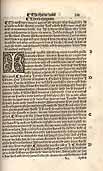 |
MORE, Sir Thomas
A dyaloge ... Wheryn be treatyd dyuerss maters, as of the veneracyon and
worshyp of ymages ... Wyth many other thyngys touchyng the pestylent secte
of Luther and Tyndale
[London: William Rastell], 1530
Bv.2.3
This is a copy of the second edition; the first edition was shortened in
the English works of 1557 to A dialogue concerning heresies and
matters of religion.
This Dyaloge is the most readable of More's controversial works. He
imagines that a friend has sent him an inquirer, the tutor of his sons,
who is perturbed by the teaching of Luther and wishes to discuss the
doubts that have come into his mind. So the book takes the form of a
dialogue between More and this Messenger, carried on partly in More's
study and partly in his garden. A fortnight elapsed between Book 2 and
Book 3; during this interval the Messenger discussed his problems with an
old University friend. There is no problem here, as in Utopia,
of distinguishing More's views, for he speaks in his own person. It is a
true dialogue since the Messenger is allowed to put his points fully; he
is not invented simply to put up a series of arguments to be knocked down,
though, inevitably, in the end he is persuaded that Luther and Tyndale
were heretics. Tyndale's Answer unto Sir Thomas More's Dialogue was
published in the spring of 1531. To this More replied with a
Confutation of Tyndale's answer: books I-III were published in 1532,
and books IV-VIII in 1533. A ninth book, unfinished, was published after
his death. |
Robert Wyer
Robert Wyer worked at the sign of St John the Evangelist in the Bishop of
Norwich's Rents (known after the sale in 1536 as the Duke of Suffolk's Rents) at
Charing Cross, where he seems to have begun printing around 1529. Most of his
books were small works on popular subjects, many of them little more than
tracts, and for the most part very poorly printed. His device shows the
Evangelist writing the Book of Revelation on the island of Patmos, with an eagle
on his right holding an inkhorn. Below is the name Robert Wyer and a merchant's
mark. One state of this device has the name wrongly spelt Wyre. Wyer was one of
the first English printers to specialize in cheap books for the uneducated, and
he brought out a number of books containing recipes, particularly in the field
of popular medicine.
The last notice of Robert Wyer is found between 1559 and 1561 in the registers
of the church of St Martin's in the Fields. He was succeeded at the sign of St
John the Evangelist by Thomas Colwell in 1560.
MOULTON, Thomas
This is the myrrour or glasse of helthe necessary & nedefull for euery
person to loke in
[London: Robert Wyer, before 1536]
Cm.2.29
Thomas Moulton was a Dominican who called himself 'Doctor of Divinity of the
Order of Friar Preachers.' This work, which deals partly with medicine and
partly with astrology, was first printed by Robert Wyer before 1531. It proved
popular and at least twenty editions were published up to 1580.
This is the only known copy of this edition. There is also in the Hunterian
Library a copy of an edition entitled: This is the glasse of helth. A great
treasure for pore men [London]: Robert Wyer, [1550?], of which only one
other copy is known, at Wisconsin University.
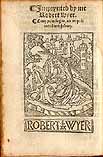 |
HIPPOCRATES
Prognosticacion, drawen out of the bookes of Ipocras, Auicen, and other
notable auctours of physycke, shewynge the daunger of dyuers syckenesses.
[London]: impryntd by Robert Wyer, [1530?] in
Au.4.11
BACON, Roger
This boke doth treate all of the beste waters artifycyalles.
[London]: imprynted by Robert Wyer, [1530?] in
Au.4.11
PROCLUS, Diadochus
The descripcion of the sphere of the frame of the worlde
London: imprynted by Robert Wyer, 1550 in
Au.4.11
VIGO, Johannes de
This lytell practyce of Johãnes de Vigo in medycyne is translated out of
Laten in to Englysshe for the health of the body of man
[London:] imprynted by Robert Wyer, [1552?] in
Au.4.11
These are typical specimens of the small cheap handbooks of popular
science and information which Wyer published. They are all very rare. The
Proclus is the only known copy, while of the Bacon and the Vigo only one
other copy of each is known. |
Thomas Berthelet
Berthelet was of French descent. He is said to have been apprenticed to
Pynson, but this is by no means certain. On 2 February 1530 he received the
royal patent as King's Printer in succession to Pynson. In this capacity he
printed a large number of proclamations, of which many survive. He was a busy
printer for a quarter of a century and seems to have retired from active control
of the business in 1548, when it was carried on from the same address by his
nephew, Thomas Powell.
In 1544, in return for £212.10s paid into the King's Treasury, Berthelet was
granted certain property in perpetuity: a house in St Bride's parish called
'Salisbury Place', several houses in Friday Street and Distaff Lane, and two
dwellings in Fleet Street, all of which had been previously owned by religious
houses. On the accession of Edward VI, Berthelet was replaced as King's Printer
by Richard Grafton, and during the ensuing years he was less active. He died in
1555.
HUTTEN, Ulrich von
Of the wood called guaiacum, that healeth the French pockes.
Londini: in aedibus Thomae Bertheleti, 1539
Af-f.29
This is a translation of De Guaici medicina published at Mainz in 1519.
The translator was Thomas Paynell, an Augustinian canon of Merton Abbey,
Surrey.
Ulrich von Hutten had suffered from syphilis for more than ten years and had
tried many remedies. The best results seemed to have been obtained from a
concoction of Guaiacum wood, and at the bidding of his friend, Dr Paulus
Riccius, he decided to tell the world of its benefits. The book was very popular
and was translated into German and French as well as English.
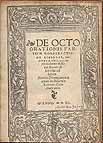 |
LILY, William
De octo orationis partium constructionis libellus
London: Thomas Berthelet, 1540
Bv.3.25
Lily's Latin Grammar - really a compilation of work by Lily, John Colet
and Erasmus, much altered as time went on - appeared in Latin at Basle in
1515. In 1540 Henry VIII issued a proclamation auhorising it as the only
grammar to be used in schools; the first English edition (An
introduction of the eyght partes of speche) appeared in 1542-3. In
1758 Lily's grammar was 'transformed and appropriated' by Eton College and
from then until 1868 it was known as the Eton Latin Grammar.
This is Ben Jonson's copy, with his inscription on the title page. |
GUEVARA, Antonio de
The golden boke of Marcus Aurelius
Londini: in officina Thomae Berthleti typis impress., 1542
BD1-e.53
First published in 1535, this translation of a French version of Guevara's El
redox de principes was very popular in England and was regarded as a moral
handbook for the education of princes. The translator was John Bourchier, 2nd
Baron Berners (1467-1533), who was Chancellor of the Exchequer in 1516 and
Deputy of Calais, 1520-1533. The exalted style employed in this book anticipated
the euphuism of Lyly.
Antonio de Guevara (1490-1545) was Bishop of Mondoñedo and confessor of Charles
V. His Familiar letters were also very popular in an English version.
John Byddell
John Bydell, printer and bookseller, was for some time an assistant to Wynkyn
de Worde, of whose will he was one of the executors. He set up as a stationer
and at first had books printed for him by others, including his old master. His
shop by Fleet Bridge bore the sign of Our Lady of Pity, and for some reason he
called himself John Salisbury, perhaps because he was a native of that town.
After the death of De Worde he moved to that printer's premises, the Sun in
Fleet Street. Byddell published in all some fifty or more books, mainly
theological, until his death, which probably took place in 1545. He used several
devices in his books, the largest of which seems to have been a copy of the
device of Jean Saçon (Zacchoni) who had in turn copied his from a design in the
Historia di Milano of Bernadino Corio (1503).
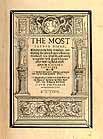 |
BIBLE. Taverner's version
The most sacred Bible, whiche is the holy scripture... translated into
English
London: prynted by John Byddell, 1539 Dw-d.12
This is a copy of the first edition of Taverner's Bible, which is a
revision of Matthew's Bible of 1537.
Richard Taverner (1505?-1575), the author of this revision, was born in
Brisley in Norfolk. He was a scholar of both Oxford and Cambridge and
received his Master's degree at Cambridge in 1530. He had a high
reputation for Greek scholarship, and was at this time Clerk of the King's
Signets, and in the employ of Thomas Cromwell. He lost his position under
Queen Mary but under Queen Elizabeth was appointed High Sheriff of
Oxfordshire.
In his corrections of the text, Taverner aimed at compression and
vividness. Many marginal notes are omitted and some new comments added.
Taverner's work exercised practically no influence on later revisions. |
Richard Grafton
Richard Grafton, a member of the Grocer's Company, and Edward Whitchurch, a
member of the Haberdasher's Company, were interested in the printing of the
Bible in English and eventually became printers and publishers, more by chance
than by design. They published the Matthew Bible in 1537 - it was printed
abroad. In 1538 they brought presses and printers from Paris to print the first
ediion of the Great Bible.
Whitchurch printed for a time in partnership with Grafton, who set up his press
in the recently surrendered house of the Grey Friars, and in 1541 they obtained
a joint exclusive privilege for printing service books; a little later they were
granted a privilege for printing primers in Latin and English.
On the accession of Edward VI, Grafton was appointed King's Printer and this
gave him the sole right to print all Acts and Statutes. He held the appointment
only for six years, for on the King's death he foolishly printed a proclamation
of the accession of Lady Jane Grey, in which he signed himself 'Printer to the
Queen'. For this indiscretion he forfeited office, which Queen Mary gave to John
Cawood. After that he did no more printing. It was not the first time he had
been in trouble with the authorities, for in 1541 he was committed to the Fleet
for printing a 'sedicious epistle of Melanctons' and was also accused by the
Privy Council of printing ballads defending the late Thomas Cromwell. In April
1543, he and seven other printers, among them Whitchurch, were sent to prison
'for printing such books as were thought to be unlawful'. In Grafton's case it
was for having printed the Great Bible. He spent six weeks in prison and was
bound in £300 neither to sell nor to print any more Bibles until the King and
clergy should agree upon a translation.
Grafton died in 1573, leaving four sons and one daughter, Joan, who married the
printer Richard Tottel. Grafton's device was a tree bearing grafts issuing from
a tun or barrel of the kind in which books were packed for transport.
BIBLE. Great Bible version
The Byble in Englyshe, that is to saye the content of all the holy
scripture... truly translated after the veryte of the Hebrue and Greke textes
[London;] prynted by Richard Grafton and Edward Whitchurch, 1539
Dt-b.1
This is a copy of the first edition of the Great Bible, which Thomas Cromwell,
as the King's viceregent, in an injunction to the clergy in September 1538,
ordered to be 'set up in sum convient place wythin the said church that ye have
cure of, where as your parishioners may moste commodiously resorte to the same
and reade it.' It is a revision by Coverdale of Matthew's Bible, which he
corrected chiefly by the aid of Sebastian Münster's Latin translation of the
Hebrew Old Testament (1534-35) and of the Vulgate and Erasmus' Latin version of
the New Testament, with the collateral help of the Complutensian Polyglot.
Coverdale worked under Cromwell's direct patronage; hence the result is
sometimes known as Cromwell's Bible. This version and its subsequent
editions are often called Cranmer's version, although Cranmer had little,
if anything, to do with their preparation, beyond adding a Prologue, which first
appeared in the second large folio edition, April 1540.
The printing was originally entrusted by Grafton and Whitchurch to Francis
Regnault, the Paris printer. But at the end of 1538 the work was suppressed by
the French authorities, and many of the sheets confiscated. Coverdale and
Grafton, however, were able to save some, and to transport the necessary
presses, type and workmen to London, where the edition was completed in April
1539.
HALL, Edward
The union of the two noble and illustre famelies of Lancastre and Yorke.
Londini: in officina Richardi Graftoni, 1548
Cn.1.4
Edward Hall (c.1499-1547) was born in London and educated a Eton and King's
College, Cambridge, where he was elected a fellow, and at Gray's Inn. He became
a common serjeant in 1532.
Hall realised that interest in English history was growing, and the time was
ripe for a work which would fully describe the Wars of the Roses. He accordingly
set to work to provide a history of those and earlier times. As he wished to
glorify the House of Tudor, Hall wrote in a dramatic style with an eye to making
his narrative effective and favourable to the Yorkist cause. Unlike earlier
publications, his work was an artistic whole. He abandoned the simple chronicle
form, and following the example of Polydore Vergil wrote a narrative of events,
coloured of course by partisan feeling, but alive and full of vivid phrase and
drama. His picture of events and of their causes profoundly influenced future
historians. The work charmed Shakespeare who used it when writing his English
historical plays, and when Holinshed and his collaborators came to write the
Chronicles that go by his name, they helped themselves freely from Hall's
work. As Hall's account came to an end in 1532, Grafton continued it up to 1546.
This copy is in a very fine sixteenth-century French binding over wood boards
and with metal bosses which were probably part of the original design. The edges
are gilded and gauffered.
William
Powell
William Powell succeeded to the business of William Middleton,
having married his widow. Powell printed continuously between
1547 and 1567 and issued more than fifty books. He probably
became a freeman of the Stationers’ Company between 1535 and
1540. He is last mentioned in the Registers in 1568 when his son
Abraham was apprenticed to H. Bynneman. On retiring from business
he married a second time, in 1569.
 |
ASKHAM or ASCHAM, Anthony
A treatyse of the state and disposition of the worlde
[London: Wiliyam Powell, 1550] Cm.2.26
This is the only known copy of this astrological work. Another
similar book by Anthony Ascham, called A litell treatyse of
astronomy, London, Wyllyam Powell, 1550, is also known only
in the Hunterian copy.
Anthony Ascham studied at Cambridge and graduated M.B. in 1540.
In 1553 he was presented by Edward VI to the vicarage of
Burneston, Yorkshire. He was probably a brother of Roger Ascham,
author of The scholemaster. |
Steven
Mierdman
Mierdman printed in Antwerp, London and Emden, and was among
the most important Netherlands printers of Reformation books.
Born about 1510 at Hooge Mierde, a village of the Netherlands
close to the Belgian frontier, he became a freeman of the city of
Antwerp in November 1543. There he printed from 1543 until some
time after 1546, when, to escape proceedings for having printed
heretical books, he came to England.
In July 1550, Mierdman, who had already taken out letters of
denization, was granted a royal licence for five years ‘to
print various books hitherto unprinted’ and to ‘employ
printers, English and foreign’. While he was in England he
printed a number of books in Latin, English, French, Italian and
Dutch, the majority being Reformation tracts, many of them by
members of the Dutch reformed Church. On the accession of Queen
Mary, Mierdman had to uproot himself once again and eventually
settled at Emden. The number of books which bear his imprint on
the title page or colophon are but a small part of his extremely
large output; he worked for a number of stationers and printed
many books bearing fictitious imprints.
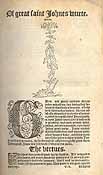 |
TURNER, William
A new herball, wherin are conteyned the names of herbes ...
London: imprinted by Steven Myerdman and soolde by John
Gybken, 1551 in Bo2-c.12
This is the first part of Turner’s great work; the second
was published in 1562 and the third in 1568, both by Arnold
Birckman of Cologne. These volumes gave the first clear,
systematic survey of English plants, and with their admirable
woodcuts, and detailed observations based on Turner’s own
field studies put the herbal on an altogether higher footing than
in earlier works. At the same time, however, Turner included an
account of their ‘uses and vertues’, and in his preface
admits that some will accuse him of divulging to the general
public what should have been reserved for a professional
audience.
William Turner was a Fellow and Senior Treasurer of Pembroke
Hall, Cambridge. While at Cambridge he published several works,
including Libellus de re herbaria, 1538. He left Cambridge
in 1640 and travelled abroad until the accession of Edward VI,
when he returned to England and eventually became Dean of Wells.
He spent much of his leisure in the careful study of plants which
he sought for in their native habitat, and described with an
accuracy hitherto unknown in England. He had nothing but contempt
for earlier herbals which he described as ‘full of unlearned
cacographies and falselye naminge of herbes’. |
William Seres
Seres began work about 1546 and was in partnership with John
Day for a few years. He afterwards joined partnership for a time
with the printer and translator Anthony Scoloker, and in 1554
received letters patent for the printing of psalters, primers and
prayer-books. This privilege he lost on the accession of Mary,
when he seems to have sought safety on the Continent, but it was
renewed by Elizabeth. In his old age he assigned his business for
a yearly rental to Henry Denham who became a member of the
Stationers’ Company in 1560. Seres lived to be Master of the
same Company for several years in succession, and died about
1579.
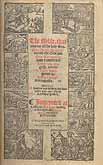 |
BIBLE. Matthew’s version
The Byble, that is to say all the holy Scripture: in whych
are contayned the Olde and New Testamente truly and purely
translated ino English
London: imprynted by Jhon Daye and William Seres, 1549 Dw-d.10
‘Matthew’s version’ was first published in 1537.
It welds togeher the best work of Tyndale and Coverdale and is
generally considered to be the real primary version of the
English Bible.
Thomas Matthew is commonly treated as a pseudonym of John Rogers
(1500-1555), Tyndale’s intimate friend, and the first martyr
in the Marian persecution. But as Rogers only edited what is
essentially Tyndale’s translation, it seems more probable
that Matthew stands for Tyndale’s own name, which it was
then dangerous to employ. Rogers’ own share in the work was
probably confined to translating the prayer of Manasses (inserted
here for the first time in a printed English Bible), and the
general task of editing the materials at his disposal, and
preparing the marginal notes, collected from various sources.
|
CASTIGLIONE, Baldassare
The courtyer ... done into Englyshe by Thomas Hoby
London: imprinted by Wyllyam Seres, 1561 BD1-d.8
Sir Thomas Hoby’s translation of Il cortegiano was
one of the key books of the English Renaissance. It provided a
philosophy of life for the Elizabethan gentleman. A reading of
its pages fitted him for the full assimilation of the elaborate
refinements of the new Renaissance society. It furnished his
imagination with the symbol of a completely developed individual,
an individual who united ethical theory with spontaneity and
richness of character.
Castiglione, after serving the Sforzas at Milan and the Gonzagas
at Mantua, came to the Court of Urbino in 1504. Here Guidobaldo
de Montefeltre and his consort Elizabetta Gonzaga were the centre
of the most brilliant court in Italy, which counted among its
members Bembo, Cardinal Bibbiena, Giuliano de Medici and many
other eminent men. His book is based on his experience of life
among these dazzling figures.
The book was translated into most European languages and between
1528 and 1616 one hundred and eight editions were published. The
English translator, Sir Thomas Hoby, travelled extensively abroad
and was knighted and appointed ambassador to France, but he died
a few months later at the age of thirty-six. His translation was
one of the most popular books of the Elizabethan age.
Thomas
Purfoot
Thomas Purfoot, senior, was born in 1518. He appears to have
been a bookseller for a number of years before he began to print.
In the Charter of Incorporation of the Stationers’ Company,
1557, his name appears in the list of freemen. The first book
with his imprint is dated 1564 and he printed about sixty books
in all. In 1588 he printed as the assign of Richard Tottel. His
son, Thomas Purfoot, junior, was in partnership with him from
1591 until his death in 1615, when the copyrights and business of
the firm passed to his son.
After an active career of almost forty years, John Day died on 23
July 1584, at Walden in Essex, and was buried in the parish
church of Bradley Parva, Suffolk. He was twice married, and is
said to have had thirteen children by each of his wives. His son
Richard followed his father’s profession and another son,
John, became a Fellow of Oriel College, Oxford, and vicar of
Great Thurlow.
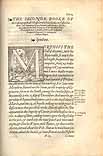 |
CUNINGHAM, William
The cosmographical glasse, conteinyng the pleasant
principles of cosmographie, geographie, hydrographie, or
navigation
Londini: in officina Ioan. Daij, 1559 BD1-a.5
This was one of the first books to call attention to John Day for
the excellence of his workmanship. ‘As a piece of
printing,’ writes Updike in his Printing types,
‘nothing better had hitherto appeared in England.’ The
text is set in a handsome italic, probably cut by François
Guyot, and used also by Nicholas Hill and Richard Tottel. The
book contains diagrams and maps, a portrait of the author, and a
plan of Norwich as well as a number of large woodcut pictorial
initials, one of which is signed I.B., possibly John Bettes,
while others bear the monogram of an I within a C. These were
almost certainly cut by Jean Croissant, a French woodcutter who
worked for Thielman Kerver in Paris.
William Cuningham was a physician, an astrologer, and an
engraver. He graduated M.B. at Corpus Christi College, Cambridge,
in 1557, and M.D. at Heidelberg in 1559. In 1563 he became a
public lecturer at Surgeons’ Hall. Besides the present book,
his chief works were Commentaria in Hippocratem and Organographia. |
ASCHAM, Roger
The scholemaster
London: John Daye, 1571 in Bv.3.23
Roger Ascham was born in Yorkshire and went to St John’s
College, Cambridge, of which he became a fellow. Under the
influence of Sir John Cheke, he learned Greek and the beautiful
‘chancery’ italic handwriting for which both became
famous. Ascham taught Greek and mathematics, and on Cheke’s
retirement in 1546 became Public Orator to the University.
Shortly aferwards he was appointed tutor to the Princess
Elizabeth, to which circumstance he owed his preferment after her
accession.
The scholemaster was occasioned by a debate at dinner with
Sir William Cecil and others on the pros and cons of flogging in
schools, with Ascham the protagonist of the anti-floggers.
Afterwards Sir Richard Sackville begged him to write a treatise
‘on the right order of teaching’ and the result was The
scholemaster. It is not a general treatise on educational
method, nor was it intended for use in schools, but a
‘plaine and perfite way of teachying children to understand,
write and speake in Latin tong ... for the brynging up of youth
in gentlemen and noblemens houses.’ Nor was it really an
original or revolutionary work, for the famous plea for gentle
persuasion, as opposed to flogging, had been anticipated at
Winchester and had already found support in England. The
expression of this humane spirit, however, and the lively defence
of the vernacular in The scholemaster - and perhaps also
the touching description of Lady Jane Grey reading the Phaedo while
everyone else was out hunting - have made it famous.
BIBLE, N.T. Gospels. Anglo-Saxon and English. 1571
The Gospels of the fower Evangelistes translated in the
olde Saxons tyme out of Latin into the vulgare toung of the
Saxons
London: printed by Iohn Daye, 1571 Bv.3.21
An edition of the Gospels in Anglo-Saxon (translated from the
Vulgate) and English (the Bishops’ version), published under
the direction of Matthew Parker, Archbishop of Canterbury.
Day’s Anglo-Saxon type had first been used in 1567, in
Aelfric’s A testimonie of antiqutie. Harry Carter and
Christopher Ricks, in their foreword to Edward Rowe More’s A
dissertation upon English typographical founders and founderies, (1961)
doubt the assertion that Day cut the letters himself, and think
it likely that the Roman letters were of Flemish origin and that
the runes mixed with them were made in London by one of
Day’s foreign journeymen.
The preface by John Foxe (1516-1587), the martyrologist, includes
a sketch of the early versions of the Scriptures, and the
literary work of Bede, King Alfred, and others. Foxe lived with
Day in 1564 and worked one day a week in his house for a longer
time.
This was Archbishop William Laud’s copy and has his
signature on the title-page. Laud gave the book to St John’s
College, Oxford, of which he was President, in 1617; later it was
in the possession of the Rev. Robert Whitehall, Vice-Principal of
New Hall, Oxford. His library was sold by Benjamin Shirley
‘at Mrs Weaver’s Dancing-School in Holywell,’
Oxford, on March 11, 1700, when this volume was bought by
‘J. Urry’, probably John Urry (1666-1715), B.A.,
Oxford, and editor of Chaucer.
Richard Jugge
Richard Jugge was an eminent printer, who kept a shop at the
sign of the Bible, at the North door of St Paul’s Church,
though his residence was in Newgate market, next to Christ
Church. It is thought that he was born in Waterbeach in
Cambridgeshire and he was educated at Eton and King’s
College, Cambridge. He was admitted a freeman of the
Stationers’ Company in 1541 and began to print the New
Testament in English, dated 1550. Ames said he was ‘very
curious, in his editions of both the Old and New Testament,
bestowing not only a good letter, but many elegant initial
letters and fine wooden cuts.’ He was one of the original
members of the Stationers’ Company, of which he was chosen
Warden in 1560, 1563 and 1566, and Master in 1568, 1569, 1573 and
1574. On the accession of Queen Elizabeth he became Royal Printer
conjointly with Cawood. He survived Cawood for a few years, in
which he enjoyed the privileges of the patent alone, but he
discovered that this was a heavy undertaking. With all the other
work that flowed into his printing house from the patent, he
found difficulty in organizing the production of Bibles. An
octavo Testament took him two years to complete, and whereas
Grafton and Whitchurch had issued seven folio Bibles in three
years, Jugge managed only two in the same period. This rate of
production was unsatisfactory to the Government and to the
Church. after ‘long hearing and debating of grievances’
Jugge was instructed to limit himself to the quarto Bible and to
the Testament in sixteenmo.
Jugge’s device consisted of a massive architectural panel
adorned with wreaths of fruit, etc., and bearing in the centre an
oval, within which is a pelican feeding her young. On the left of
the oval stands a female figure, having a serpent twined round
her right arm, who is called on the tablet beneath her Prudencia,
and upon the left is another female figure with a balance and a
sword, called Justicia.
Jugge died in 1577 and his will was proved on 23 October of that
year. His business was carried on by John Jugge who was probably
Richard’s son.
NEW TESTAMENT
The newe Testament of our Saviour Jesu Christe. Faythfully
translated out of the Greke.
London: imprynted by Rycharde Jugge [1552] [Dv-g.15]
This is Tyndale’s version, revised by Jugge. It is a copy of
the earliest of three illustrated quarto editions of this
version, printed by Jugge, and ascribed to the dates 1552, 1553
and 1566. The book contains new introductions and notes. On the
verso of the title page there is The copy of the byll assigned
by the kynges honorable counsell, for the auctorisinge of this
Testamente. This sets the price of unbound copies at
‘twenty and two pens.’
The illustrations include woodcuts of the Evangelists and
Apostles, many cuts in the Gospels (in one of which the Devil
with a wooden leg appears as the Enemy sowing tares), and 21 cuts
in Revelation. There are also ornamental blocks, initial letters
(some flourished), etc. Over one hundred blocks are used, some of
which occur in earlier editions of the Bible and New Testament.
ROESSLIN, Eucharius
The birth of mankynde
[London: Richard Jugge], 1565 Ah-c.17
This work, the first printed textbook for midwives, was
originally published at Strassburg in 1513 with the title Der
swangern Frawen und Hebammen Roszgarten. The author, who died
in 1526, was a physician at Worms and later at Frankfurt-on-Main.
He compiled the book mainly from Soranus of Ephesus’ Gynaecia.
It was very popular, and went through numerous editions and
was translated into Dutch, Czech, French, Latin and English. This
English translation by Thomas Raynalde was first published in
1540 and there were in all seventeen editions of it, the last in
1654.
The copy belonged to William Herbert, the bibliographer.
BIBLE. Bishops’ version.
The holie Bible conteyning the olde Testament and the newe.
London: imprinted by Richard Iugge, 1568. 2 vols Ds.a.12
This is a copy of the first edition of the Bishops’
Bible, a revision of the Great Bible version, undertaken by
Matthew Parker (1504-1575), Archbishop of Canterbury, with the
assistance of many bishops and well-known Biblical scholars.
In April 1571 the Convocation of the Province of Canterbury
ordered that copies of this edition should be placed in every
cathedral, and as far as possible in every church; and enjoined
every ecclesiastical dignitary to exhibit a copy in a prominent
place in his house for the use of his servants and guests. The
cost was 27s 8d per copy, a large sum in those times.
This has been described as ‘perhaps the most sumptious in
the long series of folio English Bibles’ both for its
typography and illustrations. There are numerous copperplate
engravings, including two engraved title-pages and portraits of
the Earl of Leicester and Lord Burghley, and also several maps,
plans and tables.
John Cawood
John Cawood (1514-72) came of an old Yorkshire family of some
substance and was apprenticed to John Reynes, who is best known
as a bookbinder and who died in 1543 or 1544. In 1553 Cawood
replaced Richard Grafton as Royal Printer. For his official
salary of £6. 13s. 4d. per annum, Cawood was directed to print
all ‘statute books, acts, proclamations, injunctions, and
other volumes and things, under what name or title soever’
in English, with the profit appertaining. He was also granted the
reversion of Reyner Wolfe’s patent, authorized in 1547, for
printing Latin, Greek and Hebrew books, for which he was to
receive an additional 16s. 8d. per annum ‘and all other
profits and advantages thereto belonging.’ He never enjoyed
this reversion, for he died a year before Wolfe.
In 1553 Cawood seems to have acquired a certain amount of
printing material from Steven Mierdman, who on the accession of
Mary had been obliged to leave England. In that year a number of
books printed by Cawood contain initials formerly used by
Mierdman.
Upon the incorporation of the Stationers’ Company in 1557,
Cawood was one of the Wardens and he became Master in 1561, 1562
and 1566. During his lifetime Cawood was a great benefactor of
the Company, though unfortunately his gifts perished in the Great
Fire.
As Queen’s Printer to Mary, Cawood was responsible for
printing the proclamations and acts published during her reign,
but on the accession of Elizabeth, the proclamation to that
effect was printed by Richard Jugge, who subsequently printed
several others and was termed in a letter from the Privy Council
dated 20 December, 1558, ‘the Quenes majesties
Prynter.’ On 25 January, 1559, Cawood’s name was
conjoined with Jugge’s in the printing of An Acte whereby
certayne offences be made treason, and from that time they
continued jointly to print the State papers.
Cawood died in 1572, and had been three times married. His device
consisted of his mark and initials.
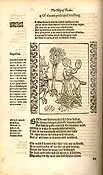 |
BRANDT, Sebastian
Stultifera navis ... The ship of fooles
London: imprinted by Iohn Cavvood, 1570 SM
1923
The original German edition, entitled Narrenschiff, was
published in Basle in 1494. This English translation (partly
translation and partly imitation) by Alexander Barclay was first
published by Pynson in 1509.
Alexander Barclay (1475?-1552) was born most probably in
Scotland, may have studied at universities in England, France and
Italy, and in 1508 was chaplain of Ottery St Mary, Devon. Perhaps
about 1511 he became a monk of the Benedictine monastery of Ely;
later he assumed the Franciscan habit; and he died at Croydon.
William Bullein, a contemporary, descibed him thus: ‘Then
Bartlet, with an hoopyng russet long coate, with a pretie hoode
in his necke, and five knottes upon his girdle, after Francis
trickes. He was borne beyonde the cold river of Twede. He lodged
upon a swete bed of Chamomill, under the Sinamum tree: about him
many Shepherdes and shepe, with pleasaunte pipes; greatly
abhorring the life of Courtiers, Citizens, Usurers and
Banckruptes &c whose olde daies are miserable. And the estate
of Shepherdes and countrie people he accoumpted moste happie and
sure.’
The volume also contains The mirrour of good maners,
translated by Barclay from the Latin of Dominic Mancini, and Certayne
egloges by Barclay. |
Henry
Bynneman
Bynneman’s career as a printer lasted from 1566, when he
became free of the Stationers, until 1583. He had been
apprenticed to Richard Harrison in 1560, but that printer died
about January 1563 and Bynneman served the remainder of his
apprenticeship with Reyner Wolfe. He became one of that select
group of printers to whom Archbishop Parker extended his
patronage.
Through the good offices of Leicester and Hatton, Bynneman
obtained a privilege to print ‘all dictionaries in all
tongues, all chronicles and histories whatsoever.’ It was
the only privilege he could obtain and not a particularly
valuable one, but it enabled him to print Holinshed’s Chronicles,
which came out in 1577.
Bynneman had three presses, and, as the inventory of his property
shows, he had a varied stock of type, including Greek and Hebrew.
He was the first printer in England to use a script of the kind
known as civilité or ‘secretary.’
Bynneman died in 1583, leaving a widow and several children, one
of whom, Christopher, was in 1600 apprenticed to Thomas Dawson.
The business was taken over by the Eliot’s Court Press.
MASCALL, Leonard
A booke of the art and maner, howe to plante and graffe all
sortes of trees
London: imprinted by Henry Bynneman for Iohn Wight, 1569 Ah -
d.27
Here is a full and detailed account of growing, tending, and
improving orchards, including what to do about caterpillars, how
to prevent frostbite, and, principally, how to graft trees for
the best results. The work is illustrated wih many woodcuts
showing the methods described in the text and a plate of the
tools used.
Leonard Mascall, who died in 1589, was clerk of the kitchen to
Archbishop Parker. In addition to the present work, he wrote
books on poultry, cattle, fishing, and ‘remedies’. In
1573 he drew up the Registrum Parochiae de Farnham.
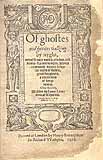 |
LAVATER, Ludwig
Of ghostes and spirites walking by nyght ... translated
into English by R.H.
London: printed by Henry Benneyman for Richard Watkyns, 1572 Ag -
d.24
The German original of this work was published at Zurich in 1569.
So immediate and widespread was its popularity that a Latin
translation appeared in the following year, a French translation
was published in Geneva and Paris in 1571, and in various
languages the book went through more than sixteen editions during
the course of a century.
Lavater, a son-in-law of Bullinger, was among the most famous of
the second generation of Calvinist theologians and later became
head of the Zwinglian church at Zurich. He denied that ghosts of
the dead could appear; he believed that apparitions were seen but
that they were the work of demons. The book was a potent stimulus
to witchmania.
The translator was Robert Harrison, the Norfolk Brownist, who
died about 1585. He is also credited with having compiled Two
right profitable and fruitfull concordances to the Bible.
The first two leaves were printed by Richard Jugge, but the rest
of the book was th work of Bynneman. |
OCLAND, Christopher
Anglorum praelia
Londini: apud Radulphum Nuberie, ex assignatione Henrici
Bynneman typographi, 1582 BD1-g.33
This work contains a poetic history of English battles on land
and sea from Edward III to Queen Mary, and then of the peaceful,
prosperous government of Elizabeth. It was appointed by Queen
Elizabeth and her Privy Council to be received and taught in
every grammar and free school within the kingdom ‘for the
remouing of such lasciuious poets as are commonly reade and
taught in the said grammar schooles.’
In addition to Anglorum praelia, with separate title pages
but continuous signatures, there are two more parts: De
pacatissimo Angliae statu and Alexandri Neuilli Kettus,
siue de furoribus Norfolciensium Ketto Duce liber unus, an
account of Kett’s rebellion, 1575.
Thomas Dawson
Thomas Dawson, senior, was a printer in London from 1568 to
1620, at The Three Cranes in the Vintry. He was apprenticed to
Richard Jugge in 1559 and took up his freedom in 1568. At the
beginning of his career he was in partnership with Thomas
Gardiner, their first book entry appearing on 2 November 1576.
Dawson was chiefly a trade printer and his business appears to
have been a large one. In the return made to the Bishop of London
in May 1583, he is entered as having three presses. He rose from
Renter of the Stationers’ Company in 1591-2 to the
Mastership in 1609 and 1615. He died in 1620, and was succeeded
in the business by his nephew, John Dawson.
 |
FLORIO, Giovanni
Florio his first fruites
London: imprinted by Thomas Dawson, for Thomas Woodcocke, 1578 SM
1138
The First fruites is primarily a text book for the
teaching of Italian. It consists of grammar and fourty-four
dialogues, the text of which is given in Italian and English,
arranged in parallel columns on th same page. The dialogues are
graded, being simple at the beginning and growing in difficulty
towards the end. The ‘familiar speech’ speech section
at the beginning gives a most interesing sketch of life as really
lived in Elizabethan London. At the end Florio gives some rules
intended to help Italians to pronounce English. These are
interesing as evidence for the pronunciation of English at this
date.
Florio’s Italian lessons were designed, not only to teach
Italian, but also to lead up to a refinement, a polish, an
elaboration in the learner’s English style. His influence
among a fairly large circle of pupils may have played some not
unimportant part in the rapid final development of the euphuistic
manner.
Since Florio was tutor to the Earl of Southampton, Shakespeare
must have met him at Southampton House. Love’s
labour’s lost owes something to Florio’s Fruites,
including its title, and some scholars think that Holofernes
was a jocular portrait of Florio. Echoes of Florio’s books
are also to be found in King Lear and Othello. |
Thomas
Vautrollier
Vautrollier was a Frenchman from Troyes in Champagne. As he
was a Huguenot he had to leave France and he was granted letters
of denization in England on 9 March 1562. Admitted a Brother of
the Stationers’ Company on 2 October 1564, he began his
career as a bookbinder and bookseller. In 1567 Vautrollier, in
association with another Huguenot bookseller, Jean Desserans,
acted as London agent for the Antwerp printer-publisher,
Christopher Plantin. Towards the end of 1568 his partnership was
dissolved, possibly because Vautrollier had by that time set up
as a printer on his own account. The preface to his first book is
dated January 1569.
From 1570 until 1587 Vautrollier worked as a printer in London,
with two brief interludes in Edinburgh, and during that time he
built up a substantial business. He managed to secure some
valuable privileges and patents from the Crown, mainly in Latin
books. The bulk of his work was in octavo editions notable for
the beauty of their type and the high standard of the presswork.
In July 1580, at the instance of the General Assembly of the
Church of Scotland, he was invited to set up a press in
Edinburgh, for although Alexander Arbuthnot was working in that
city his slowness in providing Bibles seems to have annoyed the
Assembly, which felt that a more active man was needed. In 1583
Vautrollier set up his press in Edinburgh where he was patronized
by royalty and had the honour of printing in 1584 the first of
King James’s published works. In 1584 he printed eight books
in Edinburgh, but in 1585 only two. There seems to be
insufficient business to warrant his staying there and he
returned to London in 1586. He was taken ill on his return to
London and the work of the firm was superintended with
considerable ability - as it had been during his absences - by
his wife and his apprentice Richard Field, who had been with him
since 1579. Vautrollier died in1587 and the business passed into
the hands of Richard Field, who married Vautrollier’s widow.
 |
MERBURY, Charles
A briefe discourse of royall monarchie ... Wherunto is
added ... a collection of Italian proverbes
London: imprinted by Thomas Vautrollier, 1581 SM
1147a
Merbury dedicated this book to Queen Elizabeth, probably in the
hope that she would find the politics (a defence of absolute
monarchy) agreeable and that she would be flattered by the
recognition of her proficiency in the Italian tongue. The
dedicatory epistle is in Italian, the text of the Briefe
discourse in English; the Proverbi vulgari section is
entirely in Italian except for some marginalia in English. The
collection of Italian proverbs was the first to be published in
England where such collections soon became popular. Merbury
states in his preface that he collected them ‘for the
benefit of such young gentlemen, as are studious of th’
Italian tongue’ and that he gathered them ‘in divers
places of Italie, and out of sondry approved authors.’
Merbury, who graduated at Oxford in 1570, had travelled in France
and Spain, and had entered the household of the Earl of Sussex.
In his preface he states that he was ‘then attending in
Courte upon her Maiesties service.’ Nothing is known of his
subsequent career. |
Henry Denham
Denham was one of the outstanding printers of the sixteenth
century. He was apprenticed to Richard Tottel and took up the
freedom of the Stationers’ Company on 30 August 1560. In
1564 he set up his own printing house in White Cross Street,
Cripplegate, but in the following year he moved to Paternoster
Row, at the sign of the Star, where he remained for many years.
His printing office was well supplied with good ype in all sizes,
from nonpareil to great primer, and he had a fine range of
initial letters, ornaments and borders. He was particularly fond
of arranging his titles with a lace border formed of
printers’ flowers and showed much ingenuity in their
arrangement.
When Henry Bynneman died in 1583 he appointed Denham and Ralph
Newbery to be his executors. Shortly after this it is thought
that Denham started the Eliot’s Court Printing House.
Denham was an industrious printer and in 1583 was returned as
having four presses; in 1586-7 and 1588-9 he served as Junior
Warden of the Stationers’ Company, but he never became
Master. About 1585 he removed to Aldersgate Street. The last
entry under his name occurs in the Registers on 3 December 1589,
after which nothing more is heard of him. Richard Yardley and
Peter Short succeeded to the business.
 |
HUNNIS, William
Hunnies recreations: conteining foure godlie and
compendious descourses
London: Henrie Denham, 1588 BD1-l.40
This copy is possibly unique. It is,
moreover, a bibliographical curiosity, as the book was apparently
imposed for ‘half-sheet imposition’ in sixes with
cutting but folded as whole sheets of 12°, without dividing the
sheet longitudinally in addition to cuting off the feet, so that
each leaf is duplicated.
The volume also contains another work by Hunnis, Seven sobs of
a sorrowfull soule for sinne, printed by Henrie Denham in
1589, of which only one other (imperfect) copy is recorded.
Hunnis, who was a musician and poet, was a gentleman of the
Chapel Royal under Edward VI and was made Master of the Children
by Queen Elizabeth in 1566. He died in 1597. |
John
Charlewood
Charlewood commenced business early in Mary’s reign in
partnership with John Tisdale, in Holborn. He was a member of the
Grocers’ Company until about 1574, though he took out
licences to print books. From 1562 to 1593 he printed
continuously and issued a very large number of books. His address
was the Half-Eagle and Key in the Barbican, and in one of the
Marprelate tracts it is stated that as printer to the Earl of
Arundel he had a press in the Charterhouse. He was known to be
one of the ring-leaders of the gang of printers who printed
pirated copies of texts to which they had no rights. His widow
married James Roberts, who thus succeeded to the business.
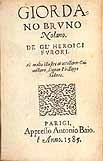 |
BRUNO, Giordano
1. De la causa, principio, et uno
Venetia [ie London: John Charlewood] 1584 [1585] Db.3.18
2. De l’infinito universo et mondi
Venetia [ie London: John Charlewood] 1584 [1585] R.8.7
3. De gl’heroici furori
Parigi: appresso Antonio Baio [ie London: John Charlewood]
1585 Cm.3.26
4. Cabala del cauallo Pegaseo
Parigi: appresso Antonio Baio [ie London: John Charlewood]
1585 Db.3.20
Giordano Bruno, who is often called the most modern of all the
thinkers of the Renaissance, was born in 1548 and entered the
Dominican Order at the age of sixteen; soon, however, he began to
hold heretical opinions, and eventually left his monastery. He
travelled extensively throughout Europe before coming to England
in 1583 to settle for a while, writing and publishing in London,
and in Oxford claiming the right to lecture. He left England for
France in 1586 and from there went to Germany, where he taught
for a couple of years. In 1589 he returned to Italy where he was
denounced to the Inquisition. He spent eight years in prison and
was burnt at the stake in 1600.
These four works and two others were all published during or
immediately follwing Bruno’s visit to Oxford University.
They were obviously the backlog of works which he had accumulated
during his years of wandering and exile. A fictitious foreign
imprint helped the sales in England of a book in a foreign
language. Charlewood obviously hoped that this stratagem would
provide easier and increased sales for these books, which would
allow the printing of a larger and more profitable edition. His
hopes were apparently not realised since none of them were
reprinted in Italian in Great Britain until modern times. |
Robert
Waldegrave
Robert Waldegrave was born about 1554, the son of a
Worcestershire yeoman. He was apprenticed to William Griffith, a
stationer, in 1568, and was made free of the Stationers’
Company in 1576. He made his first entry in the Registers in
1578. He was imprisoned in 1584 and 1585 for printing Puritan
books and in 1588 he became involved in printing the Martin
Marprelate tracts, which attacked the bishops, and was forced to
move his press from place to place in order to avoid discovery.
By 1589 he had had enough of this and he is said to have fled to
La Rochelle and there printed two more Puritan tracts. He then
proceeded to Edinburgh where in 1590 he was appointed King’s
printer and he remained there until 1603, printing nearly one
hundred books. In 1603 he returned to London and died there in
1604.
HETH, Thomas
A manifest and apparent confutation of an Astrological
discourse
[London:] printed by Robert Walde-graue, by the assent of
Richard Watkins, [1583] BD19-i.25
An astrological discourse was by Richard Harvey,
astrologer and brother of Gabriel Harvey the poet. Harvey
incurred much ridicule for his predictions and the Discourse was
parodied by Thomas Nashe. Thomas Heth or Heath was an M.A. of All
Souls’ College, Oxford, and a mathematician. The book is in
the form of a letter to Sir George Carey.
This copy belonged at one time to William Herbert (1718-1795),
the bibliographer, and is described in his enlarged edition of
Ames’s Typographical antiquities. Later it belonged
to James Orchard Halliwell-Phillipps (1820-1889), biographer of
Shakespeare, scholar and Librarian of Jesus College, Cambridge.
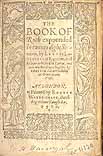 |
LAVATER, Ludwig
The Book of Ruth expounded in twenty-eight sermons.
London: printed by Robert Walde-grave, 1586 BD1-h.48
This work was translated from Latin by Ephraim Pagitt
(1575-1647), who was then eleven years old. His father, Eusebius
Pagitt, a puritan minister, was deprived for nonconformity in
1585 and remained without a charge from then until the death of
Whitgift in 1604. The book is dedicated to the Duchess of
Somerset, the Countess of Bedford, and three other ladies, and in
his dedicatory epistle Pagitt writes that he has dedicated it to
them from ‘a desire to yeeld thankes for the comfort which
I, my brother and Sisters (poore children) haue reciued by the
kindenes, which hath often come from you to us & our parents
in our necessities.’ Ephraim Pagitt grew up to be a
heresiographer, author of Christianographie (1635), and Heresiographie
(1645).
This copy formerly belonged to William Henry Havergal
(1793-1870), composer of sacred music. |
Richard
Tottel
The earliest of the ‘class’ monopolies was that for
law books, and of all the monopolies this was possibly the least
obnoxious, for such work was highly specialized and unsuited to
the average printer. Richard Tottel, who obtained from Philip and
Mary a patent to print for seven years ‘duly authorized
books on common law’ is said to have obtained his privilege
‘at the suit of the judges.’ This privilege was allowed
and confirmed by the Stationers’ Company soon after its
incorporation, and at the expiration of the seven years Tottel
received from Queen Elizabeth a life grant to ‘imprint all
manner of books concerning the common law of this realm.’
Tottel worked for forty years in Fleet Street at the sign of the
Hand and Star. Although law books were his chief publications, he
was a lettered man, and the few volumes that he printed apart
from his law books were of literary merit.
Tottel was an original member of the Stationers’ Company,
and became Master in 1578 and 1584. He married a sister of
Richard Grafton and this probably led to his printing editions of
Grafton’s Chronicles as well as gaining possession of
that printer’s best woodcut borders. Towards the end of his
life he retired to Wiston in Pembrokeshire, where he died in
1593.
 |
HOWARD, Henry, Earl of Surrey, and others
Songes and sonettes written by Lord Henry Howard late Earle
of Surrey, and others
[London:] apud Richardum Tottell, 1567 Cn.3.4
Tottell’s Miscellany, as it was called, was first
published in June 1557. The present copy is of the fifth edition
which is said to be the most correct of the early editions.
Of the two hundred and eighty poems included in the collection,
forty were contributed by Lord Henry Howard, who was not actually
Earl of Surrey, but only so called out of courtesy. The largest
and most important contribution was that of Sir Thomas Wyatt
(1503-1542), from whose works ninety-six poems were selected.
Nicholas Grimald (1519-1562) originally contributed forty poems,
thirty of which were subsequently dropped. Of the one hundred and
thirty-four poems by ‘uncertaine auctours,’ two have
been identified as by Thomas, Lord Vaux, one by John Heywood, and
one by Edward Somerset. The rest still remain unidentified,
although it is reasonably certain that Thomas Churchyard and Sir
Thomas Bryan were among the authors.
Lord Henry Howard was the author of the first written blank verse
in the English language, the translation of the second and fourth
books of Virgil’s Aeneid, 1557. He was preceded in
print, however, by Grimald, who contributed some blank verse to
this miscellany, originally published a few weeks earlier. |
BRACTON, Henry de
De legibus et consuetudinibus Angliae libri quinque
Londini: Richard Tottel, 1569 Bh8-e.9
This treatise, written in the middle of the thirteenth century,
is the classical exposition of the common law, was cited in the
courts down to the eighteenth century, and has remained a model
for legal literature until the present day.
Bracton based his book on the cases decided by the great judges
of the first half of the century as well as on his own
experience. He combined a systematic inquiry into the legal
maxims of general validity with their practical application in
the common-law courts. Thus he arrived at a formulation of
principles which have determined the whole development of English
law, of which the use of precedents is perhaps the most
characteristic. His method was adopted and carried on by
Littleton and Coke. The work was edited by Sir Travers Twiss,
1878-83 and by G.E. Woodbine, 1915, and in 1887 F. Maitland
published a Collection of cases, with proofs that this was
the actual collection on which Bracton’s treatise was
founded.
Bracton, who died in 1268, was for twenty years a ‘justice
itinerant’ in the northern, midland and western counties of
England. Later he became archdeacon of Barnstaple and chancellor
of Exeter Cathedral.
LEGH, Gerard
The accedence of armories
London: imprinted by Richard Tottell, 1591 Sp Coll
1673
This is a copy of the fourth edition; the first was published in
1562. The work is written in the form of a dialogue between
‘Gerard the Herehaught and Legh the Caligat Knight,’
and although put forth as an elementary treatise is in reality a
medley of irrelevant learning. Richard Argall of the Inner Temple
wrote the address To the reader and probably part of the
latter passages of the book. Legh is purposely obscure for fear
of trenching on the official privilege of the College of Arms.
Legh was at first a draper, later a member of the Inner Temple.
He died of the plague in 1563. On fol. 133 of the book there is
what appears to be a portrait of him in the guise of a
‘herehaught.’
Nicholas Hill
Nicholas Hill or Montanus or van de bergh was a native of the
Low Countries who came to England in 1519 and took out letters of
denization in 1544. In 1546 the first book with his name in the
imprint was issued, and between then and 1553 he printed
twenty-three books, mostly for other people. He appears to have
done no retail trade as a bookseller and this is probably the
reason why his house had no sign. He died about 1553.
GEMINI, Thomas
Compendiosa totius anatomie delineatio, aere exarata
London: Nycholas Hyll, [1553] Ab.1.9
One of the earliest books containing copperplate engravings
produced in England; the plates are supposed to have been some of
the first rolling press work done there. Thirty-eight of the
forty plates were copies from Vesalius’s De humani
corporis fabrica, Basle, 1543, and the remaining two from his
Epitome of the same date.
The text is similar to that used by Thomas Vicary in his Anatomie
of the bodie of man, 1548, but rearranged. The book also
contains the only English translation of the descriptions of the
drawings in the Fabrica. The translation and arrangement
of the text was the work of the dramatist Nicholas Udall.
John Wayland
John Waylamd began business in 1537 when he printed three
books. In 1539 he printed several issues of Bishop Hilsey’s Primer
or had them printed for him by John Mayler; they were sold
also by Andrew Hester and Michael Lobley. After this we know
nothing of his work for several years. Apparently at the
beginning of Mary’s reign Edward Whitchurch, who had got
into trouble, gave up his shop in Fleet Street at the sign of the
Sun and this was taken by Wayland who, in October 1553, procured
a patent for the sole printing of all primers and manuals of
prayers howsoever denominated, as likewise for all such books as
he should first print for and during the term of seven years from
the date thereof. For the next three years he was busy and
printed about twelve books, but his work seems to have brought
him little success. In his will dated 1556 he left nothing but
‘desperate debts.’
BOCCACCIO, Giovanni
The tragedies, gathered by Jhon Bochas, of all such princes
as fell from theyr estates thoughe the mutability of fortune
London: imprinted by John Wayland, [1555?] BD8-b.9
This verse adaptation of Boccaccio’s De casibus virorum
illustrium was first published by Pynson in 1494.
Wayland’s undated edition is a reprint of Pynson’s
second edition of 1527. It was originally intended that this
edition should be supplemented by some of the
‘tragedies’ of English men and women which were later
printed under the title of The mirour for magistrates. This
copy has at the end a special title for the supplementary
tragedies which reads: A memorial of suche Princes, as since the
tyme of King Richard the seconde, haue ben unfortunate in the
Realme of England. Londini In aedibus Johannis Waylandi, cum
priuilegio per Septenniam. The letters patent, dated 1553, are
printed on the verso of this title and here Mary is described as
supreme head of the Church of England. This supplement was
apparently suppressed by the authorities.
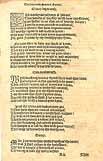 |
BIESTON, Roger
The bayte and snare of fortune
London: imprinted by John Wayland: [1556?] Bo3-b.13
This dialogue between man and money is written in eight-line
stanzas with a complex rhyme scheme. In the prose prologue on the
verso of the title-page the author maintains that avarice is the
beginning of all the mischief in the world. His name is given on
the last page in an acrostic, Rogerus Bieston. |
Thomas East
East, a Buckinghamshire man, printed at five addresses in
London. He became free of the Stationers’ Company on 6
December, 1565, but there is no record of his apprenticeship. As
a printer his name first occurs as having printed for Francis
Coldocke a translation by Peter Beverley of Ariosto’s History
of Ariodanto and Jeneura, which, though undated, may be
ascribed to the year 1566.
For a time East printed in association with Henry Middleton, a
partnership which continued until 1572, during which time they
printed a number of medical and theological works, and also
lighter and more ephemeral matter.
As appears from an examination of the list of East’s
printings, until 1587 almost every category of literature was
represented, and in the main he worked for the well-known
booksellers such as John Wight, Lucas Harrison, William Norton,
John Harrison the younger, Francis Coldocke and others. Then in
1588 he began to print music and became the first regular English
music printer and publisher. This came about because at the end
of 1587 William Byrd assigned the privilege which he held to
print and sell all musical works to East. In 1594 East no longer
styled himself as Byrd’s assign, and after the
composer’s patent expired in 1595, for the next three years
East and Peter Short were printing music, presumably by licence
from the Stationers’ Company. In 1598 a fresh patent was
granted to Byrd’s pupil, Thomas Morley, who assigned
licences to East, Short, and a publisher named William Barley.
The last few years of the sixteenth century and the beginning of
the seventeenth saw the publication of most of the masterpieces
of the English madrigalists.
The exact date of East’s death is not known, but it was
prior to June, 1609, that the copyrights of some of his books
were transferred to Thomas Snodham, alias East, ‘with the
consent of Mistress East.’ The copyright of the music books
was transferred in 1610 to the bookseller John Browne, and in
1611 copies were entered again in the names of Matthew Lownes,
John Browne and Thomas Snodham.
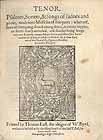 |
BYRD, William
Psalmes, sonets, and songs of sadnes and pietie, made into
musicke of five parts
[London:] printed by Thomas East, the assigne of W. Byrd, 1588 R.a.10
In 1575 William Byrd was granted conjointly with Thomas Tallis
the sole right to print and sell, or allow to be printed and
sold, all musical works in England. After Tallis’s death in
1585, Byrd, as the survivor, still held on to his patent, and at
the end of 1587 assigned the privilege to Thomas East, who
printed these part-songs for him. Copies of four editions of this
publication have been preserved, three dated 1588 and the fourth
undated. This is a copy of the third edition of 1588.
William Byrd (1543-1623) was born probably in Lincoln. His early
life is obscure, but it is likely that he was one of the children
of the Chapel Royal, under Thomas Tallis, and at the age of
twenty he became organist of Lincoln Cathedral, where he remained
until 1572, when he was made joint-organist with Tallis of the
Chapel Royal. In 1575 Tallis and Byrd published a joint work, Piae
cantiones, which was dedicated to Queen Elizabeth. Byrd was
associated with John Bull and Orlando Gibbons in Parthenia
(1611), the first printed music for virginals. A firm Catholic,
Byrd, who is often regarded as the greatest of the Tudor
composers, was several times prosecuted as a recusant, but he
wrote music of great power and beauty for both the Catholic and
the Anglican services, as well as madrigals, songs, and music for
strings. |
BYRD, William
Songs of sundrie natures, some of grauitie, and others of
myrth, fit for all companies and voyces.
London: imprinted by Thomas East, the assign of William Byrd,
1589 R.a.9
It was not until 1588, through the successful working of the
music patent by William Byrd and Thomas East, that part books of
madrigals were produced in any quantity in England. British
performers before this time came to know their polyphonic music
mostly from continental editions and from manuscripts. In his
address To the courteous Reader in this volume Byrd
writes: ‘Finding that my last Impression of Musicke (most
gentle Reader) through thy curtesie and favor, hath had good
passage and utterance: and that since the publishing thereof,
because I would shew my selfe gratefull to thee for thy loue, and
desirous to delight the with varietie, whereof (in my opinion) no
Science is more plentifully adorned then Musicke. For which
pupose I do now publish for thee, songs of 3. 4. 5. and 6. parts,
to serve for all companies and voyces.’ All six parts are
present in this copy.
WATSON, Thomas
The first sett, of Italian madrigalls Englished, not to the
sense of the originall dittie, but after the affection of the
noate.
London: imprinted by Thomas Este, the assigné of William Byd,
1590 R.a.14
Part-singing was a favourite pastime among the English in the
sixteenth and seventeenth centuries, and the average educated
Elizabethan liked nothing better than to join in a madrigal. The
music for each voice was printed separately and the part-books
were laid on the table for all who would to join in. This is a
fine set in six parts - Superius, Medius, Contratenor, Tenor,
Bassus and Sextus.
William Byrd, at the request of Watson, contributed to this
collection two settings of his madrigal This sweet and merry
month of May. Most of the other music is by the Italian
composer Luca Marenzio. The work is dedicated in Latin elegiacs
to the Earl of Essex, with a Latin eulogy in the same meter on
Marenzio. Watson, the poet, was so highly rated by his fellow
poets and men of letters that he was even declared to be the
equal of Petrarch, Theocritus and Virgil. He was the first
English writer of sonnets after Surrey and Wyatt, and his sonnets
were closely studied by Shakespeare and other contempories, and
have left their mark on English literature. He was the Amyntas of
Spenser’s Colin Clout’s come home again. He was
also deeply interested in music and was an intimate friend of the
chief musicians of the day.
WEELKES, Thomas
Madrigals to 3. 4. 5. and 6. voyces
London: printed by Thomas Este, 1597 R.a.45
Thomas Weelkes was organist of Winchester College and of
Chichester Cathedral. Besides the present work, he published Balletts
and Madrigals to five voyces 1598 and 1600, Madrigals of
5. and 6. parts, 1600, and Ayeres or phantasticke spirites
for three voices, 1608. He also contributed As vesta was
from Latmos Hill descending to the Triumphs of Oriana, and
he left in manuscript anthems and instrumental pieces.
John Wolfe
As a young man John Wolfe appears to have been a member of the
Fishmongers’ Company, but the earliest definite record is
the entry of his apprenticeship to John Day of the
Stationers’ Company in 1562. There is no record of his entry
into the Stationers’ Company, and by his own admission he
only served ‘the said John Day by the space of seaven yeares
in the trade of printinge.’
At some time between 1569 and 1579 Wolfe went to the Continent
and studied printing in Italy. He was almost certainly working in
Florence in 1576, for there exist two Representazioni printed
‘In Fiorenza ad instanzia di Giouanni Vulfio Inglese,
1576.’ It is also probable that he lived in
Frankfurt-am-Main for some time, and that while he was there he
established a connection which enabled him to market his books at
the annual Fair after he had returned to England. The very first
book entered to him in the Register and printed in 1579 was sent
to the Frankfurt Fair in 1581, and he continued to send books
there quite regulaly until 1591.
It was only in 1581 that Wolfe actually started his career as a
London printer, possibly for the first year in partnership with
Henry Kirkham. He soon became embroiled in disputes with the
printers who held privileges to print certain classes of books
but by 1583 he allowed himself to be bought off and was formally
entered on the registers of the Stationers’ Company.
Wolfe was an energetic and ambitious printer with the mechanical
resources to produce almost a tenth of the total volume of
material printed in London, but because of the continued
opposition of the vested interests, he tended to be short of good
copy to print. He therefore hit on the idea of reprinting
editions of popular and well known Italian works which could not
be reprinted by Italian printers because of their appearance in
the newly established Index Librorum Prohibitorum. Besides
this, there was a widespread interest in Italian literature in
England at the time. Accordingly he published a number of Italian
books but gave them false Italian imprints.
In 1587 Wolfe was appointed Beadle of the Stationers’
Company and had four presses at work. In 1593 he became printer
to the City of London, and in 1598 he was admitted to the livery
of the Stationers’ Company. He died during the year 1601,
and several years afterwards his widow assigned over a large
number of his copyrights to John Pindley.
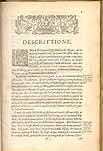 |
UBALDINI, Petruccio
Descrittione del Regno di Scotia, et delle isole sue
adiacenti
Anuersa [ie. London: John Wolfe], 1588 BG52-c.13
This is a free translation of Hector Boece’s Hystory and
croniklis of Scotland of which a transcript was made by
Ubaldini in 1550 and dedicated to Lord Arundel in 1576 (now in
the British Library). It marks the only use by Wolfe of a
fictitious imprint in a work by Ubaldini. The manuscript of this
work is in the Library of Corpus Christi College, Oxford.
Petruccio Ubaldini was a Florentine Protestant exile who had only
been saved from imprisonment for debt in 1579 by the intervention
of the Privy Council. He served as John Wolfe’s Italian
proofreader for the ten years during which Wolfe printed Italian
books, and then went over (or was passed) to Richard Field, who
succeededd Wolfe as the principal Italian printer in London.
Between 1545 and 1563 Ubaldini lived partly in Italy, partly in
England; from 1563 until his death sometime after the turn of the
century he lived in England, supporting himself by teaching
Italian and calligraphy, by transcribing and illuminating
manuscripts for presentation to various actual or prospective
patrons, by writing, and by cadging as he could. He always took
great care to have his short works printed in quartos, or even in
folios, with large margins, large clear type, and plenty of
ornaments to make them look as beautiful and as fashionable as
possible. The same motive could also have prompted him to
camouflage their ordinary English source with the suggestion of a
more interesting foreign origin. |
SPENSER, Edmund
The faerie queene
London: printed [by John Wolfe] for William Ponsonbie, 1590 Sp
Coll 171
First edition of the first part of The faerie queene containing
books 1-3.
Ponsonby was the publisher of Sidney’s Arcadia and it
may be that the friendship which had existed between Sidney and
Spenser had something to do with Spenser’s choice of
publisher. However that may be, Ponsonby was the publisher of all
Spenser’s works, except The shepherd’s calendar. Ponsonby
entered The faerie queene in the Stationers’ Register
on 1 December 1589, Spenser having entrusted him with the
manuscript on his arrival in London from Ireland in the previous
month. Sidney’s Arcadia was then passing through the
press, and both works appeared in the following year.
Disappointed in the hope of preferment which had brought him back
to Court - though Elizabeth, to whom the work had been dedicated,
granted him a pension of £50 a year - Spenser returned
reluctantly not long afterwards to his lonely home in County
Cork.
This copy has the blanks for Welsh words on page 332,
Spenser’s letter to Sir Walter Raleigh, and ten
complimentary sonnets at end.
Thomas Orwin
Thomas Orwin was apprenticed to Thomas Purfoot and was
presented for his freedom in 1581. He succeeded to the business
of George Robinson, whose widow he married. In 1587-8 Orwin got
into trouble with the Court of Star Chamber, and consequently the
Company ordered him to cease printing until he received the
permission of that Court, but on 20 May following a letter was
received by the Company, signed by the Archbishop of Canterbury,
the Bishop of London and others, in consequence of which Orwin
was admitted a master printer. In 1591-2 his press was seized by
the Company, presumably for printing ‘popish’ books. He
died before 25 June 1593, and was succeeded by his widow, Joan
Orwin. Orwin sometimes used the device of an urn marked with his
initials, at others that of two hands clasping each other, and
the motto ‘By wisdom peace by peace plenty’. A third
device was that of Mars standing with sword and shield.
FLORIO, Giovanni
Florios second frutes .. To which is annexed his Gardine of
recreation.
London: printed for Thomas Woodcock [by Thomas Orwin], 1591 SM
1138a
The proverb plays an all-important part in the twelve dialogues
of the Second frutes, which are, indeed, a kind of
corollary to the Giardino di ricreatione. The Giardino is
a list of about six thousand Italian proverbs, without their
English equivalents, arranged in roughly alphabetical order. It
is one of the most important of the earlier collections of this
kind. The dialogues are arranged to show as many of the proverbs
as possible in use. In the Italian column, every phrase which is
proverbial is marked with an asterisk. In his epistle To the
Reader Florio compares his work on Italian proverbs with that
of Erasmus in Greek and Latin or Heywood in English and
reiterates his intense belief in the value of popular sayings,
which are ‘the pith, the proprieties, the proofes, the
purities, the elegancies, as the commonest so the commendablest
phrases of a language.’
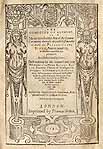 |
RIPLEY, George
The compound of alchemy
London: imprinted by Thomas Orwin, 1591 Ag-e.18
George Ripley was born about 1415, in Yorkshire, according to
some authorities, but at Ripley in Surrey according to Camden. He
became a canon regular of St. Augustine at Bridlington, and
devoted himself to the study of physical science, especially
alchemy. To acquire fuller knowledge he travelled in France,
Germany, and Italy, and lived for a long time at Rome, where in
1477 he was made chamberlain by Pope Innocent VIII. In 1478 he
returned to England in the belief that he had the secret of
transmutation. He pursued his alchemical work, but his labours
became irksome to the abbot and other canons so he was released
from the Order and joined the Carmelites at Boston, where he died
in 1490.
Ripley’s name is attached to as many as twenty-five works,
most of which remain in manuscript. Whether or not they are by
him may be doubted, but the present work is universally
acknowledged to be his. It was one of the most popular works on
alchemy and manuscript copies circulated widely. This is a copy
of the first printed edition. The title has a woodcut border;
there is an ornamental initial E containing a portrait of Queen
Elizabeth, to whom the book is dedicated, and M3 recto is taken
up with the diagram called Ripley’s Wheel.
This copy has the bookplate of Thomas Gaisford (1779-1855), Dean
of Christ Church, Oxford. |
Adam Islip
In 1578 Adam Islip, who was originally bound to Hugh Jackson,
stationer, was set over to Thomas Purfoot for the remainder of
his term of apprenticeship. During this time he was concerned
with Roger Ward and others in printing John Day’s A B C, etc.,
without licence. Ward admitted that Adam Islip had furnished him
with some type from Thomas Purfoot’s printing house, without
Purfoot’s knowledge. There is no record of any punishment
having followed this offence, and Islip was admitted a freeman of
the Stationers’ Company in 1585. His first book entry occurs
in 1591. In 1595 he took into partnership for a while William
Moring, and about 1606 he sold his printing house for £140 to
Robert Raworth and John Monger. Islip immediately set up another
printing house, and in 1615 was returned as having two presses.
He died in 1639.
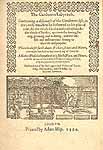 |
HILL, Thomas (compiler)
The gardeners labyrinth
London: printed by Adam Islip, 1594 Ah-e.34
This work contains ‘instructions for the choise of seedes,
apt times for sowing, setting, planting, and watering, and the
vessels and instrumentes seruing to that use and purpose,’
and sets forth ‘diuers herbers, knots and mazes, cunningly
handled for the beautifying of gardens. Also the phisicke benefit
of ech herb, plant, and floure, with the vertues of the distilled
waters of euery of them.’ The illustrations are valuable for
their detail of the small Elizabethan garden, and are especially
interesting in their depiction of people working in their
gardens.
Thomas Hill was an astrologer who also worked for the booksellers
as a compiler and translator. In addition to gardening, he
produced works on the interpretation of dreams, astrology,
arithmetic and physiognomy. |
ROWLANDS, Samuel
The betraying of Christ. Judas in despaire: with poems on
the Passion
London: printed by Adam Islip and to be sold by Henry Toms,
1598 BD1-c.55
The woodcut title border of this very rare tract shows symbols of
the Passion. Next follows Rowlands’ dedication ‘To his
deare affected friend, Maister H.W. Gentleman’ and seven
stanzas of six lines, inscribed ‘To the Gentlemen
Readers.’ All the poems are written in the same measure,
except The high way to Mount Caluarie which is in
four-line stanzas.
Rowlands was the author or supposed author of a number of tracts
in verse and prose. In 1825 Dibdin wrote: ‘I firmly believe
that a complete collection of his pieces, low, queer, comical,
and contradictory as they may be, could not be procured under the
sum of 300 sovereigns.’
Eliot’s
Court Press
After Bynneman’s death most of his ornaments, borders and
pictorial initials came into the possession of a syndicate of
four men: Edmund Bollifant, Arnold Hatfield, John Jackson and
Ninian Newton. Bollifant, Hatfield and Newton were stationers and
printers, and had served their apprenticeship with Henry Denham,
one of Bynneman’s assigns. Jackson was a member of the
Grocers’ Company; he does not seem ever to have been a
printer, and probably provided the capital for the partnership,
which set up as printers to the trade in Eliot’s Court,
Little Old Bailey.
The formation of this syndicate seems to have been welcomed by
the more important booksellers and for more than a decade
stationers such as George Bishop, Ralph Newbery, Francis
Coldocke, John and Bonham Norton, employed the Eliot’s Court
Press which took as its device the mark of a caduceus. Although
the syndicates held stock and printing material in common, their
names never appear all together in the imprint to any book they
issued.
Newton’s name does not appear after 1586, Jackson’s is
not found after 1596, and Bollifant died in1602, his place being
taken by Melchisidec Bradwood. Arnold Hatfield is believed to
have died in 1612.
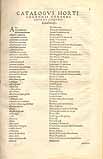 |
GERARD, John
Catalogus arborum, fruticum ac platarum tam indigenarum,
quam exoticarum, in horto Johannis Gerardi
Londini: ex officina Arnoldi Hatfield, impensis Ioannis
Norton, 1599 BD14-a.18
Gerard (1545-1607), a native of Cheshire, was a ‘master in
chirurgerie’ but was better known as a remarkably successful
gardener. For twenty years he supervised the gardens belonging to
Lord Burleigh in the Strand, and at Theobalds in Hertfordshire,
besides having himself a famous garden in Holbotn, then the most
fashionable district of London. This catalogue of 1033 plants and
trees which he cultivated there was first published in 1596. It
was the first complete catalogue ever published of the contents
of a single garden. |
GERARD, John
The herball or Generall historie of plantes
London: Edmund Bollifant for B. and J. Norton, 1597 Bk10-d.4
This is a copy of the first edition of Gerard’s famous Herball,
important among other things for having the first
illustration of the potato. The publisher, Norton, had
commissioned Robert Priest to translate Dodoens’ Stirpium
historiae pemptades sex but Priest died before the work was
printed. His manuscript came into the hands of Gerard, who
changed Dodoens’ arrangement for that of Pena and de
l’Obel, added many English localities and some homely
observations on the uses of the plants, and published the work as
his own.
The book contains about 1800 woodcuts, nearly all from blocks
used by Tabernaemontanus in his Eicones of 1590, which
Norton obtained from Frankfort; less than one percent are
original.
Richard Field
Richard Field was born in Stratford-upon-Avon in 1561 and was
bound apprentice to George Bishop for seven years in 1579. It was
agreed that he should serve the first six years with Thomas
Vautrollier. During his two lengthy trips to Scotland,
Vautrollier’s London business was probably carried on by
Field under the supervision of Vautrollier’s wife
Jacqueline. Field was his only apprentice, although in Letters
Patent granted to him in 1574 he had been allowed the help of
‘six woorkemen Ffrenchmen or Dutchemen, or suche lyke, for
the sayd space or terme of tenne yeres wythout any lett or
dysturbance of any person or persons.’ It can be assumed
that these men were skilled craftsmen; but they would still have
to be closely directed, and while working with them Field would
have acquired not only knowledge of their languages but also some
insight into the special problems involved in printing in foreign
languages.
Thomas Vautrollier died in July 1587, only a few months after the
admittance of Field to the Stationers’ Company on 6 February
1587. In March 1588 Vautrollier’s widow married Field and he
thus succeeded to one of the best printing businesses in London.
His first book entry is found in the Registers under 24 December
1588. On 23 April Field entered in the Registers ‘a booke
intituled Venus & Adonis.’ This was followed in
1596 by a third edition of the same work, in octavo. Like John
Wolfe, Field surreptitiously printed a number of foreign books,
some as political propaganda and others for presentation to
patrons and friends of the author.
About 1600 Field removed from Blackfriars to the parish of St
Michael in Wood Street, at the sign of the Splayed Eagle. In 1615
he was returned as having two presses. He became a prominent
member of the Stationers’ Company, of which he was elected
Master in 1619 and 1622. Field died in 1624 and his business
passed into the hands of George Miller, one of his apprentices.
 |
ARIOSTO, Ludovico
Orlando Furioso in English heroical verse, by John
Harington
London: imprinted by Richard Field, 1591 Bm6-f.20
Sir John Harington (1561-1612) was educated at Eton and
Cambridge. From Cambridge he went to the court of his god-mother,
Queen Elizabeth. His wit brought him into much favour, which he
endangered by the freedom of his satires. In 1599 he served under
Essex in Ireland and was knighted by him on the field, much to
the Queen’s displeasure. He is chiefly remembered for this
translation of Orlando Furioso; his other writings include
Rabelaisian pamphlets, epigrams, The metamorphosis of Ajax
(1596), containing the earliest designs for a water-closet, and
The Englishman’s doctor, a translation from Salerno.
Harington’s translation is in the octave stanza of Ariosto,
and is magnificently illustrated, the engraved title, by Cockson,
containing portraits of Ariosto and of Sir John Harington and his
dog. The engravings, although sometimes said to be English, were
in fact printed from the Italian plates of Giralamo Porro, of
Padua, and had been used before in Italy. Shakespeare may have
borrowed from this work for part of Much ado about nothing and
The Tempest. |
GUICCIARDINI, Francesco
The historie of Guicciardini: containing the
warres of Italie and other partes
London: imprinted by Richard Field, 1599 Bn6-c.7
This translation of Guicciardini’s L’historia
d’Italia, first published in 1579, was the greatest literary
undertaking of Sir Geoffrey Fenton. It was extremely popular, and
seems to have recommended the author to the Queen’s favour
permanently. Soon after its publication, he went to Ireland,
under the patronage of Arthur, Lord Grey de Wilton, where he was
sworn into the Privy Council, in 1580. He was knighted in 1589
and remained in Ireland as principal secretary of state through a
succession of lord deputies.
Guicciardini’s history extends over forty years from 1494 to
1534. During the latter half of this period Guicciardini was in
the papal service as governor successively of Modena, Reggio,
Parma, the Romagna, and Bologna. The fact that he was himself a
conspicuous actor in the scenes enabled him to write with a
peculiarly intimate knowledge of the events and the personages of
contemporary politics. Keenly observant, he was in the habit of
recording his impressions of men and things, and it was his
mental turn to record them in the form of aphorisms. His history
is, therefore, rather the maxims and memoranda of a statesman,
scientifically arranged, than a philosophical view of human
affairs.
Peter
Short
Peter Short may be considered the last of the more famous
printers of the sixteenth century, for his active career extended
from 1590 to his death in 1603. Although he printed many books
for his own account he was also a trade printer, working for
William Ponsonby and other well-known London stationers. For John
Harrison the younger he printed in 1598 an edition of
Shakespeare’s Lucrece and for Andrew Wise, in the same year,
he printed Henry IV, part I, in a quarto which bore no
author’s name. Short took over Henry Denham’s business
and material after the latter’s death, and completed the
edition of Foxe’s Booke of martyrs begun by Denham. He was
an active printer for he issued about one hundred and thirty
books. He was admitted a freeman of the Stationers’ Company
by redemption on a March, 1589, and died in 1603.
MORLEY, Thomas
A plaine and easie introduction to
practicall musicke
London: imprinted by Peter Short, 1597 B.a.4
The most famous of Elizabethan teatises on music, this book went
through several editions and was reprinted as late as 1771.
Morley’s work on the theory and practice of music has
enabled scholars to understand the full scope of music in the
time of Shakespeare. Commentators have stated that this is the
source from which many of his references to music were derived.
Thomas Morley (1557-1604?) was a pupil of William Byrd. He was
organist of St Paul’s Cathedral and a gentleman of the
Chapel Royal. He composed graceful madrigals and church music.
 |
GILBERT, William
De magnete
Londini: excudebat Petrus Short, 1600 Ah-x.15
This is a copy of the first edition of a book which has been
described as the first major original contribution to science
which was published in England. In it Gilbert established the
magnetic nature of the earth; and he conjectured that terrestrial
magnetism and electricity were two allied emanations of a single
force. He was the first to use the term ‘electricity’,
‘electric force’ and ‘electric attraction,’
and to point out that amber is not the only substance which when
rubbed attracts light objects. The gilbert unit of magneto-motive
power is named after him.
Gilbert (1540-1603) was elected fellow of St John’s,
Cambridge, in 1561, and in1573 settled in London. He became
president of the College of Physicians and was physician to Queen
Elizabeth I and James I. On the title-page of this book is the
device of the brazen serpent on a Tau cross printed from the
identical block used by Reyner Wolfe fifty years before in his
edition of Cranmer’s Defence of the ... doctrine of the
Sacrament, 1550. From his widow it passed to Henry Bynneman,
thence to Denham, and so to Peter Short. |
Christopher
Barker
An outstanding figure in the printing trade towards the end of
the sixteenth century was Christopher Barker, a shrewd
businessman who managed to acquire the most lucrative of all
patents, namely the Bible patent. Born around 1529, Barker was a
wealthy member of the Drapers’ Company with powerful friends
at court, for he was closely connected with the Walsingham
family. He is thought to have been the grand nephew of Sir
Christopher Barker, a former Garter King of Arms, which would
explain his wealth, since the various properties of Sir
Christopher ultimately passed into the possession of his nephew,
Edward Barker, thought to have been the printer’s father.
Barker became interested in the printing trade and is first heard
of as a publisher in 1569. In 1576 he started on his career as a
Bible printer, having obtained a privilege to print the Geneva
version of the Bible in England. In 1577 he purchased from Sir
Thomas Wilkes, Clerk of the Privy Council, an extensive patent
which included the Old and New Testament in English, with or
without notes, of any translation. The full patent granted to
Barker the office of royal printer of all statutes, books, bills,
Acts of Parliament, proclamations, injunctions, Bibles, and New
Testaments, in the English tongue of any translation, all service
books to be used in churches, and all other volumes ordered to be
printed by the Queen or Parliament.
Barker’s business continued to thrive and from 1588 onwards
he conducted it mainly through his deputies, George Bishop and
Ralph Newbery. On the disgrace of Wilkes in 1589, Barker managed
to obtain a renewal of his exclusive patent with reversion for
life to his son Robert. Father and son lived in London at Bacon
House in Noble Street, Aldersgate. Christopher Barker also had a
house at Datchet, to which he retired after 1588, and there he
died in 1599. He and his deputies had supplied the country with
about seventy editions of the Scriptures between 1575 and 1599
and they were accurate and well printed. He was succceeded in the
post of royal printer by his son Robert.
 |
LA PLACE, Pierre de
A treatise of the excellencie of a Christian
man, and how he may be knowen
London: imprinted by Christopher Barkar [sic], 1576 BD1-k.40
A translation of Traitté de la vocation et manière de vivre à
laquelle chacun est apellé by Laurence Tomson.
Pierre de la Place was born about 1520 at Angoulème. He studied
at the University of Poitiers and subsequently went to Paris
where in time he became President of the Cour des Aides. In 1560
he became a Protestant and had to leave Paris because of
persecution. On his return he was made overseer of the household
of the Prince de Condé. A few years later he was again
persecuted - his house was sacked, his library pillaged, his
money sequestered and he was deprived of his office. Finally he
was murdered in the massacre of St. Bartholomew, 1572. Laurence
Tomson (1539-1608) was secretary to Sir Francis Walsingham. He
was a graduate of Oxford, had travelled extensively and knew many
languages. He translated and revised the Geneva New Testament. |
BIBLE. Geneva version
The Bible that is, the Holy Scriptures
conteined in the Olde and Newe Testament
London: imprinted by Christopher Barker, 1576 Ds.d.5
Christopher Barker prined two folio editions of the Geneva
version of the Bible in 1576. These were the first folio editions
of his version printed in England. The Geneva version was a
translation made by William Whittingham, Anthony Gilby, Thomas
Sampson, and perhaps others, at Geneva, where a band of English
reformers had found asylum. It was the first printed, in a quarto
edition, by Rowland Hall at Geneva in 1560. This first edition
was printed in roman type and Barker printed his editions in
roman type too, instead of the black letter usually favoured by
English printers of the Bible at that time.
In this edition a large two-page plan, The forme of the Temple
and citie restored, is inserted at Ezekiel. Some of the initials
contain the arms and crest, or the crest alone, of Sir Francis
Walsingham, Barker’s patron. This copy has the bookplate of
Lt. Col. Edwin Richbell.
CHURCH OF ENGLAND. Liturgy and ritual
The booke of common prayer
London: imprinted by Christopher Barker, [1581?] in G.x.27
The book of common prayer was first published by Edward
Whitchurch in 1549. It was the first single manual of worship in
a vernacular language directed to be used universally by, and
common to, both priest and people. Its original simplicity, which
has not been lost in the many subsequent revisions, has ensured
its permanence; and deservedly so, becuase it is one of the
greatest of all liturgical rationalizations, combining as it did
the four main service books of pre-Reformation days, the Missal,
Breviary, Manual and Pontifical, and abolishing all the different
regional variations contained in the diocesan uses. From these
four service books came the main structure of the Prayer Book,
and with translations from other liturgical sources, they formed
the contents. To these were added the Collects, which were
Archbishop Cranmer’s own contribution, along with the
translation into English whose simplicity and vigour are still
apparent.
The Litany was compiled and published in 1544, the English
version of the Epistles and Gospels followed in 1548 and the
first complete Book of common prayer was issued and enjoined by
the Act of Unifomity of 1549. A considerably altered text was
introduced in 1522 to satisfy a more extreme Protestant point of
view, and minor alterations of a Catholicizing tendency were made
in 1561 and again in 1604. The last major alteration took place
after the Restoration in 1662, when several hundred alterations
were made.
|